Module 6
| Site: | MoodleHUB.ca 🍁 |
| Course: | Biology 30 SS |
| Book: | Module 6 |
| Printed by: | Guest user |
| Date: | Friday, 19 December 2025, 4:20 AM |
Description
Created by IMSreader
Table of contents
- 1. Module 6
- 1.1. Big Picture
- 1.2. In this Module
- 1.3. Lesson 1
- 1.4. Page 2
- 1.5. Page 3
- 1.6. Page 4
- 1.7. Page 5
- 1.8. Lesson 2
- 1.9. Page 2
- 1.10. Page 3
- 1.11. Page 4
- 1.12. Page 5
- 1.13. Lesson 3
- 1.14. Page 2
- 1.15. Page 3
- 1.16. Page 4
- 1.17. Page 5
- 1.18. Lesson 4
- 1.19. Page 2
- 1.20. Page 3
- 1.21. Page 4
- 1.22. Page 5
- 1.23. Lesson 5
- 1.24. Page 2
- 1.25. Page 3
- 1.26. Page 4
- 1.27. Page 5
- 1.28. Lesson 6
- 1.29. Page 2
- 1.30. Page 3
- 1.31. Page 4
- 1.32. Lesson 7
- 1.33. Page 2
- 1.34. Page 3
- 1.35. Page 5
- 1.36. Lesson 8
- 1.37. Page 2
- 1.38. Page 3
- 1.39. Page 4
- 1.40. Lesson 9
- 1.41. Page 2
- 1.42. Page 3
- 1.43. Page 4
- 1.44. Lesson 10
- 1.45. Page 2
- 1.46. Page 3
- 1.47. Page 4
- 1.48. Module Summary/Assessment
- 1.49. Module Glossary
1. Module 6
Module 6—Mendelian Genetics: The Transmission of Traits to the Next Generation
Introduction
You expect to resemble your parents and your other ancestors, yet you are a little bit different. How did you inherit the traits in common with your ancestors?
A monk working with pea plants in a garden discovered how traits are inherited. If it were not for Gregor Mendel and the garden pea, genetics might still be in the Dark Ages. Using the simple garden pea, Mendel developed evidence for the basic principles of genetics.
In this module you will explore the concepts of dominance, segregation, and independent assortment. You will analyze ratios and probabilities of genotypes and phenotypes to examine many other possible ways traits can be transmitted from generation to generation. You will discover how variability can be dependent on the number of genes involved in a trait, crossing over, and gene linkage. You will also learn why some traits, like hemophilia, are more common in males than in females. There are many tools that can be used to study the transmission of traits. You will have the opportunity to use these tools in your study of some common heritable traits.
In the Biology 30 Course Introduction, several resources, including The Key and Student Notes and Problems Workbook: Biology 30, were recommended to you for additional support. As you work through Module 6, you may find the sample problems in these resources particularly helpful. There are many helpful resources at the McGraw-Hill Ryerson online learning centre at www.mhhe.com/biosci/genbio/espv2/data/genetics/index.html.
1.1. Big Picture
Module 6—Mendelian Genetics: The Transmission of Traits to the Next Generation
 Big Picture
Big Picture

© Martina Ebel/shutterstock
Has anyone ever told you that you look like someone else in your family? Do you have your mother’s eyes or your grandfather’s hairline? Would you be worried if all the men in your family were balding?
You may wonder why some people in your family look alike and some do not. Or you may wonder why some have inherited certain traits or genetic conditions, and some have not. As you look around and notice the variety of traits in your family, you may wonder what determines how and why each relative got his or her unique characteristics.
This begins the journey towards understanding the principles and steps involved in the inheritance of traits and how they are expressed. Through this journey you will consider various examples of inheritable characteristics and how they are transmitted from generation to generation. You will begin with the simple garden pea, which illustrates basic genetic principles, and move to more complicated examples of inheritance, particularly human inheritance.
In this module you will explore genetics and inheritance. To do this, you will need to explore the following focusing questions:
- What controls the physical appearance of organisms?
- How are traits inherited from generation to generation?
- How can the analysis of ratios and probabilities of the external appearance of traits reveal the internal workings of genetics?
- What tools can scientists use to study and predict inheritance?
- Why do some traits appear more frequently in males than in females?
- How can offspring demonstrate gene combinations never seen in their parents?
- Does inheritance of traits always happen the same way?
In this module it is essential to practise the concepts that you will learn by doing questions and problems. There is an extensive vocabulary in genetics and you will become familiar with many terms and how to use them correctly. In Lesson 1 you will be encouraged to start developing flash cards to record vocabulary. With each lesson, you should decide which terms you need to add to your flash cards.
You have been introduced to the focusing questions for this module. Each lesson will restate these focusing questions to guide your study. To help you organize the concepts you learn in Module 6, and to provide you with a study aid for review, you may choose to download the Module 6 Concept Organizer. Fill in this concept organizer with the ideas you master as you work through each lesson, or prepare the organizer when you have completed Module 6. You can use keywords, point form, or any amount of detail that meets your needs. You may choose to work from the file on your computer, print the document and work from the paper copy, or copy the outline onto a large sheet of poster paper. After you have prepared your concept organizer, you may wish to check your work with the concept organizer provided in the Module Summary. The concept organizer provided outlines of some of the key topics that you should include in each lesson of your concept organizer. This is a great tool to review and use for study purposes, but using this organizer is completely your choice.
In the Module Assessment for Module 6, you will choose between completing a study of Familial Mediterranean Fever or preparing a presentation on the inheritance of hemophilia in the descendants of Queen Victoria and Prince Albert. You will apply the principles that you study in each of the lessons to the completion of the assessment that you choose. For more details about the Module Assessment and the evaluation criteria, visit the Module Summary and Assessment sections.
1.2. In this Module
Module 6—Mendelian Genetics: The Transmission of Traits to the Next Generation
In This Module
Inquiry Question: What are the basic rules and steps that affect the transmission of genetic characteristics to the next generation?
There are ten lessons in Module 6.
Most of the lessons are designed to take you 80 minutes to complete; however, some lessons may take longer because of the significance of the concept being covered in the lesson. The suggested lesson times do not include the time needed to complete such activities as “Try This,” “Watch and Listen,” assignments, practice questions, review, or research.
This module corresponds to Chapter 17, pages 584 to 621, in your textbook. You will be referred to the relevant pages in each lesson.
Lesson 1: Theories and Terminology of Inheritance
In this lesson you will explore and become familiar with the language of genetics. You will be introduced to a nineteenth century monk, Gregor Mendel, and learn why he is considered the Father of Genetics.
You will consider the following focusing questions:
- What is the basic language of genetics?
- How does the work of Mendel explain the basics of classical genetics?
Lesson 2: Mendel’s Laws and Monohybrid Crosses
In this lesson, you will learn the patterns of inheritance that Mendel first discovered in pea plants. You will become familiar with techniques and conventions used by geneticists to trace the inheritance of traits from one generation to the next.
You will consider the following focusing questions:
- What are the simple principles of single trait inheritance?
- How can genotype be determined from phenotype?
Lesson 3: Multiple Alleles and Incomplete Dominance Crosses
In this lesson, you will explore traits that do not follow Mendel’s patterns of simple dominance, but can still be explained by his laws. You will understand how genes can have more than two alternate forms.
You will consider the following focusing questions:
- What happens when one allele is not completely dominant over another?
- How does having more than two alleles for a gene affect the possible phenotypes for a trait?
Lesson 4: Dihybrid Crosses
In this lesson, you will learn how to follow the inheritance of two separate traits at the same time. As you follow two traits you will understand how the movement of alleles for one trait does not affect the alleles of another trait during the formation of gametes.
You will consider the following focusing question:
- How do scientists track the inheritance of more than one trait at a time?
Lesson 5: Probability
In this lesson, you will learn how to predict the genetic outcome of future generations by examining numbers and ratios. Patterns can give the likelihood of a trait remaining hidden or being expressed.
You will consider the following focusing question:
- How can ratios be used to analyze types of inheritance or to predict the possibility of a trait appearing in the next generation?
Lesson 6: Chromosomal Theory and Sex-Linked Inheritance
In this lesson, you will begin to explore inheritance patterns that do not follow Mendel’s laws. You will see how some traits occur more frequently in one gender over another, and are said to be sex-linked.
You will consider the following focusing questions:
- Why do some traits appear more frequently in one gender than the other?
- How did Thomas Hunt Morgan’s work provide experimental support for the chromosomal theory of inheritance?
Lesson 7: Genes and the Environment
In this lesson, you will examine the effect the environment may have on the expression of genes.
You will consider the following focusing question:
- How does the environment affect the expression of genes?
Lesson 8: Polygenetic Traits
In this lesson, you will study traits that are controlled by many genes. You will recognize inheritance patterns that result in gradual changes in phenotypes, and you will understand that the expression of one gene can turn the expression of another on or off.
You will consider the following focusing question:
- How might multiple genes combine to form a single trait?
Lesson 9: Crossing Over Frequencies and Gene Mapping
In this lesson, you will learn how genes that are found on the same chromosome are termed linked because they tend to move together. You will learn how crossing over in meiosis allows scientists to map the relative location of genes that are found on the same chromosome.
You will consider the following focusing questions:
- How does crossing-over in chromosomes relate to finding the position of genes?
- What is the importance of knowing the location of specific genes on a chromosome?
Lesson 10: Plant, Animal, and Human Genetics
In this lesson, by learning to create and analyze pedigrees, you will be able to track the inheritance of rare genetic diseases through families.
You will consider the following focusing question:
- What technologies exist to help explain and predict the inheritance of traits in breeding programs and/or family histories?
1.3. Lesson 1
Module 6—Mendelian Genetics: The Transmission of Traits to the Next Generation
Lesson 1—Theories and Terminology of Inheritance
 Get Focused
Get Focused
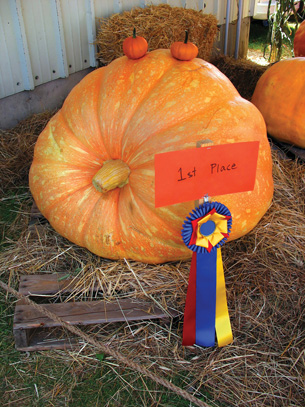
© TheSupe87/shutterstock
A prize pumpkin at a county fair must be large, well-shaped, have good orange colour, and be disease-free. These descriptors are called characteristics, and gardeners who wish to compete in county fairs are constantly selecting plant seeds that come from vines demonstrating more of the characteristics they want in their pumpkins. Breeding plants or animals to reflect desired characteristics or behaviours is called selective breeding and has been used throughout recorded history.
However, only since the 1850s have scientists developed understanding of how those desired characteristics are actually passed from one generation to the next. How these characteristics are passed on, or the study of inheritable traits, is the focus of genetics.
selective breeding: choosing stock because of its physical, behavioural, or functional characteristics
inheritable trait: a characteristic that is determined by genes, not the environment; a trait that is capable of being passed from parent to offspring
In this lesson, you will explore and become familiar with the language of genetics. In this lesson and throughout the module you will be introduced to many new terms. Your lesson assignment will involve developing flash cards to support your developing genetics vocabulary. Add to it as you work through the module. You will also be introduced to a nineteenth century monk, Gregor Mendel, and learn why he is considered the “Father of Genetics.”
In this lesson, the following focusing questions will be examined:
- What is the basic language of genetics?
- How does the work of Mendel explain the basics of classical genetics?
 Module 6: Lesson 1 Assignment
Module 6: Lesson 1 Assignment
Your teacher-marked Module 6: Lesson 1 Assignment requires you to submit
- vocabulary flash cards
You will create flash cards for each new term introduced to you throughout this lesson. You may develop your flashcards as a Word document, a PowerPoint, or any form that you choose to meet your learning style. You may wish to consult with your teacher for suggestions. Your flash cards for this lesson will only be submitted to your teacher for assessment at the end of the lesson. For additional information on this assignment and a rubric for assessment, see the Reflect and Connect section of this lesson.
In each of the following lessons, add new terms, diagrams, or tools used in genetics to complete your set of flash cards. Use your flash cards as a study tool for the terms and concepts presented in this module.
There is no assignment for this lesson.
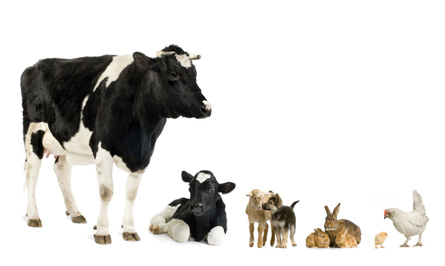
© Eric Isselée/shutterstock
The other questions in this lesson are not marked by the teacher; however, you can submit any of this work to your teacher for feedback if you require. The “Self-Check” and “Try This” questions are placed in this lesson to help you review important information and build on key concepts that may be applied in future lessons. The key to success in genetics is “practice.”
While you are completing this lesson, there will be many opportunities for you to acquire, understand, and practise the concepts that are presented to you. As you complete these activities and your summary notes, you will file everything in your course folder so that you may refer to these when you are preparing for exams.
Remember you also have the option of trying additional questions from the textbook for further practice. Consult with your teacher for the answers to these questions. The Key will also provide you with many Diploma-Exam-style multiple choice, numerical response, and written response questions that will be an excellent review of the module. Practising responding to these types of questions is good preparation for the Diploma Exam.
1.4. Page 2
Module 6—Mendelian Genetics: The Transmission of Traits to the Next Generation
 Explore
Explore
 Read
Read
Early Theories
For thousands of years, farmers have used seeds from good crops to improve the characteristics of the next year’s crop. They breed the best individuals in their livestock to improve the next generation’s chances of expressing favourable traits. How favourable traits are passed on has been the interest of scientists for centuries. Early theories tended to accord importance to the kind of life the parents led. Similar to Lamarkian’s ideas of evolution, where body parts change in response to use, many early scientists believed life’s experiences influenced the next generation’s traits. These theories were finally put to rest by a nineteenth-century, Austrian monk named Gregor Mendel. Mendel studied garden peas as his experimental subjects and, with breeding and observation, laid the foundation of our current knowledge and understanding of heredity and genetics.
Read the sections “Early Theories of Inheritance” and “Developing a Theory of Inheritance: Gregor Mendel’s Experiments” on pages 586 to 588 in your textbook. Answer the following questions to ensure your understanding. Save the answers in your course folder. Remember to create a flash card or text entry for each new term you encounter.
TR 1. Where did Aristotle believe the factors for inheritance were located in the body? How did he believe these were passed down?
TR 2. What were some of the likely problems early scientists must have encountered when trying to explain inheritance?
TR 3. Examine the seven traits Mendel studied on page 588. What do you notice about all of them?
TR 4. What is a monohybrid cross?
TR 5. Explain how a hybrid plant is different from a true breeding plant.
TR 6. Explain the difference between P, F1, and F2 generations in a cross.
monohybrid: an organism that is heterozygous for one trait (e.g., Tt)
hybrid: the offspring of two parents with different inheritable traits; often termed heterozygous
true breeding: organisms that produce offspring that express the same trait generation after generation; organisms are homozygous for a trait
P1 generation: the first set of parents; parents of the F1 generation
F1 generation: offspring of the P1 generation; F stands for filial generation—meaning brothers and sisters
F2 generation: offspring produced as a result of individuals of the F1 generation mating with other individuals of the F1 generation
 Watch and Listen
Watch and Listen
Watch the video “Classical Genetics and Monohybrid Crosses” until you reach the section “Bio Challenge: Round vs. Wrinkled Peas.” Answer the following questions for your own understanding. Consult with your teacher about the answers.
TR 7. Who discovered that cells differentiate during embryonic development and disproved the idea that the egg or the sperm held a complete miniature organism?
TR 8. Explain the meanings of the terms dominant and recessive factors (we now call these factors alleles).
TR 9. Distinguish between the terms gene, allele, and chromosome.
TR 10. What process creates gametes?
TR 11. How do we distinguish between dominant or recessive alleles when drawing them on a chromosome or in a Punnett square, which you will study in the next lesson?
TR 12. What does it mean to be homozygous for a trait? How is this different from being heterozygous for a trait?
TR 13. Using an example, distinguish between the terms genotype and phenotype.
dominant: if two alleles are present, the allele that is expressed is the dominant one (e.g., if an individual has both tall and short alleles, but is tall, then tall is dominant over short)
recessive: if two alleles are present, the allele that is hidden is recessive
homozygous (true breeding): a genotype where both alleles are the same (e.g. ,TT is homozygous dominant, tt is homozygous recessive)
heterozygous: a genotype where the alleles are different (e.g.,Tt)
genotype: what the genes say; two symbols that indicate which alleles the individuals has for a particular trait (e.g., Tt)
phenotype: the observable characteristic of the organism (e.g., tall height or short height); is determined by genotype (e.g., the Tt genotype results in a tall phenotype)

© Vasina Natalia/shutterstock
If you want more information about Mendel’s experiments, do an Internet search using search terms such as ”biology + Gregor Mendel + Experiments with Peas.” There are many animations and interactive experiments available on the web.
 Try This
Try This
From your reading and the video, apply your understanding to the following questions. Discuss your work with your teacher and save the results in your course folder.
TR 14. Why did Mendel choose to study pea plants in his experiments?
TR 15. How did he ensure that his plants were true breeding?
TR 16. What does filial mean?
TR 17. How did Mendel make sure his results were statistically accurate?
1.5. Page 3
Module 6—Mendelian Genetics: The Transmission of Traits to the Next Generation
 Read
Read
trait: a characteristic
pure: an individual with both alleles for a trait being dominant, or recessive
contrasting characteristic: a trait that has two alleles that are expressed in a different way (e.g., the trait for height in pea plants can have the contrasting characteristics of tall or short)
factor: the term used by Gregor Mendel to explain inheritance of a trait; today we use the term gene
law of segregation: the two genes that an organism has for each trait are separated during meiosis so that only one gene can enter a gamete; explains why body cells are diploid, but gametes are haploid
The video “Classical Genetics and Monohybrid Crosses” presented how Mendel discovered two variations of traits for each characteristic that he studied. One trait is dominant over the other. The evidence for this was discovered when he crossed two pure plants with contrasting characteristics, such as Tall (T) or short (t) plants. The first generation plants, or F1, all showed a Tall phenotype. The short trait seemed to disappear. However, when these plants self fertilized, their offspring, the F2, were a mix of tall and short plants. Read the section “Dominant and Recessive Genes” in your text on page 588 for a better understanding of this mode of inheritance.
Mendel proposed that each trait was controlled by factors. We now call these factors genes, and the different forms of genes are termed alleles. Each plant will have two alleles present for each characteristic, and will pass down only one of these alleles when they create gamete cells (sperm or egg). The combination of the two alleles received by a gamete is random, and this type of separation is known as Mendel’s first law: the law of segregation. For a greater understanding of this law, please read “The Law of Segregation” in your text on page 589. Summarize this law in words or a diagram and file in your course folder.
 Try This
Try This
TR 18. Complete the Terminology Drag and Drop activity.
 Self-Check
Self-Check
To check your understanding, complete the following questions.
SC 1.
- Separate the two chromosomes by meiosis.

- What type of cell is formed as a result of meiosis?
- What term is used to describe “T” and “t”?
- Which of Mendel’s Laws does the above example illustrate?
SC 2. Use the appropriate term to describe each of the following items: genotype, phenotype, segregation.
Blue eyes
a. _______________
bb
b. ________________
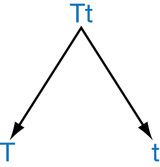
c. _________________
SC 3. Indicate whether each of the following is a trait or a characteristic.
- wrinkled seed
- curly hair
- pod colour
- plant height
SC 4. How many different types of gametes would an individual with the following genotypes produce? (Hint: Each gamete will contain only one from each letter pair.)
- AABBCC
- AaBbCc
- AaBbCC
SC 5. What are the gamete types produced by an individual with genotype WWTtPp?
SC 6. What evidence is there for Mendel’s principle of dominance?
SC 7. Which term identifies or describes the following genotypes?
- Rr/Pp –
- RR/PP –
 Self-Check Answers
Self-Check Answers
SC 1.
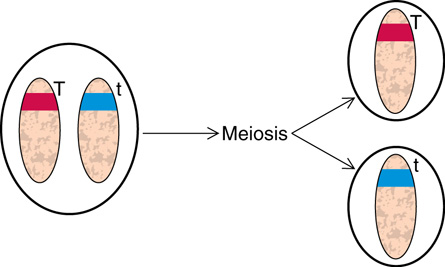
- the cells created by meiosis are called gametes
- the “T” and “t” are known as alleles, with “T” being dominant and “t” being recessive
- The Law of Segregation
SC 2. a. phenotype
b. genotype
c. segregation
SC 3.
- trait
- trait
- characteristic
- characteristic
SC 4.
- 1
- 8
- 4
SC 5. WTP, WTp, WtP, Wtp – four unique gametes
SC 6. the reappearance of the recessive trait in the F2
SC 7. a. heterozygous
b. homozygous or true breeding.
1.6. Page 4
Module 6—Mendelian Genetics: The Transmission of Traits to the Next Generation
 Reflect and Connect
Reflect and Connect
Study Dictionary or Flash Card Set
Learning to communicate in another country would be challenging without knowledge of a few terms in the local vocabulary. Working in genetics is much the same. To help you in your study of genetics, there are many terms that you need to understand. Using the new terms identified by the bold type in your textbook and in the lesson, create a flash card study set. This could be in the form of a PowerPoint presentation, an online flash card set, or a traditional 3 x 5 paper card stack. Write the term on one side and the definition on the other. You may choose to include examples because they are often helpful in illustrating a concept.
You will use your flash card set to review and study the vocabulary of each lesson as you work through the module.
Submit your work to your teacher for assessment before filing your work in your course folder. Your flash cards will be assessed according to the following rubric:
Rubric
|
4 marks |
3 marks |
2 marks |
1 mark |
Quantity |
Set has more than 10 cards |
Set has 8 to 10 cards |
Set has 5 to 7 cards |
Set has less than 5 cards |
Usefulness |
Can be used for study and shared with others |
Can be used for study or shared with others |
Appears on one page or cannot easily be mixed up or changed |
Is a simple list of terms and definitions |
Quality of Definitions |
All terms are uniquely defined and clear |
Most definitions are clear |
Many definitions require understanding of many other genetic terms |
Most definitions are copied from the text glossary |
 Going Beyond
Going Beyond
Write a fictional story while attempting to incorporate as many of your new vocabulary words as possible. After your first draft, complete a revision to add the words that you did not use in your original draft. Save your story to your course folder and post it to your class discussion area.
 Self-Check
Self-Check
To apply your understanding of Mendelian genetics, answer the following Diploma-Exam-style questions.
Ideas concerning the nature of inheritance have very early origins, but the conceptual breakthrough that established modern genetics as a science was made less than 150 years ago by an Austrian monk, Gregor Mendel.
SC 8. Alternate forms of the same gene are known as
- alleles
- gametes
- genotypes
- heterozygotes
SC 9. Mendel’s principle of segregation states that alternate forms of a gene separate during
- fertilization
- seed dispersal
- cross-pollination
- gamete formation
SC 10. An organism is heterozygous for two pairs of genes. The number of different combinations of alleles that can form for these two genes in the organism’s gametes is
- 1
- 2
- 4
- 8
Use the following information about tobiano twin colts to answer the next question.
Descriptions and Symbols Used to Represent One Type of Coat Colour in Horses
| 1 | 2 |
3 |
4 |
DNA sequence for coat colour |
TT, Tt |
T |
Tobiano (white spotting pattern) |
|
tt |
t |
Not tobiano (no white spotting pattern) |
Numerical Response
SC 11. Using the numbers above, match these descriptions and symbols with the term below to which they apply.
| Description or Symbol Number: |
||||
| _____ | _____ | _____ | _____ | |
| Term: | ||||
| gene | allele | phenotype | genotype |
 Try This Answers
Try This Answers
SC 8. A
SC 9. D
SC 10. C
SC 11. 1, 3, 4, 2
 Reflect on the Big Picture
Reflect on the Big Picture
You are developing some understanding of why you may look like someone else in your family. You may be better able to explain why you have your mother’s eyes, or your grandfather’s hairline, but there is still much to come in genetics! The determination of human eye colour is much more complicated than the simple principles developed by Mendel.
For thousands of years, people bred their livestock and plants hoping to establish desirable characteristics in the next generation. Their attempts weren’t always successful. Not until the 1850s did scientific discoveries lead to an understanding of just how these characteristics were passed from one generation to the next. Gregor Mendel, the “Father of Genetics,” was the first major contributor to these discoveries.
By examining the work of Gregor Mendel, you should now have begun to understand how one trait is passed on to the next generation. Some of them are part of a dominant/recessive pair as in Mendel’s peas. The concept of dominant alleles explains why you may show many of the same traits that you see in your parents. The concept of recessive alleles helps you understand why you may show some traits seen in your grandparents but not in your parents.
Human cells have thousands of alleles. They are not always simply dominant or recessive. As you will discover in the following lessons, there are many ways characteristics are inherited.
 Module 6: Lesson 1 Assignment
Module 6: Lesson 1 Assignment
Submit your flash cards to your teacher for assessment.
1.7. Page 5
Module 6—Mendelian Genetics: The Transmission of Traits to the Next Generation
 Lesson Summary
Lesson Summary
During this lesson you were to focus on the following questions:
- What is the basic language of genetics?
- How does the work of Mendel explain the basics of classical genetics?
By reading, and watching the videos, you have seen and heard the language of genetics being used. With your creation of a study dictionary or flash card set, you should now have begun to put that language into practice. Keep reviewing your flash card set, and add the new words that will be presented in each upcoming lesson.
Mendel used careful scientific methods to analyze the inheritance of traits in garden peas. He made clear observations, conducted many experimental trials, and worked in a controlled environment. It is thanks to his work that we were able to begin to understand just how genes are responsible for our characteristics.
Lesson Glossary
Consult the glossary in the textbook for other definitions that you may need to complete your work.
contrasting characteristic: a trait that has two alleles that are expressed in a different way (e.g., the trait for height in pea plants can have the contrasting characteristics of tall or short)
dominant: if two alleles are present, the allele that is expressed is the dominant one (e.g., if an individual has both tall and short alleles, but is tall, then tall is dominant over short)
F1 generation: offspring of the P1 generation; F stands for filial generation—meaning brothers and sisters
F2 generation: offspring produced as a result of individuals of the F1 generation mating with other individuals of the F1 generation
factor: the term used by Gregor Mendel to explain inheritance of a trait; today we use the term gene
filial: the offspring of a cross
genotype: what the genes say; two symbols that indicate which alleles the individual has for a particular trait (e.g., Tt)
heterozygous: a genotype where the alleles are different (e.g.,Tt)
homozygous (true breeding): a genotype where both alleles are the same (e.g. ,TT is homozygous dominant, tt is homozygous recessive)
hybrid: the offspring of two parents with different inheritable traits; often termed heterozygous
inheritable trait: a characteristic that is determined by genes, not the environment; a trait that is capable of being passed from parent to offspring
law of segregation: the two genes that an organism has for each trait are separated during meiosis so that only one gene can enter a gamete; explains why body cells are diploid, but gametes are haploid
monohybrid: an organism that is heterozygous for one trait (e.g., Tt)
P1 generation: the first set of parents; parents of the F1 generation
phenotype: the observable characteristic of the organism (e.g., tall height or short height; is determined by genotype) (e.g., the Tt genotype results in a tall phenotype)
pure: an individual with both alleles for a trait being dominant, or recessive
recessive: if two alleles are present, the allele that is hidden is recessive
selective breeding: choosing stock because of its physical, behavioural, or functional characteristics
trait: a characteristic
true breeding: organisms that produce offspring that express the same trait generation after generation; organisms are homozygous for a trait
1.8. Lesson 2
Module 6—Mendelian Genetics: The Transmission of Traits to the Next Generation
Lesson 2—Mendel’s Laws and Monohybrid Crosses

© Monkey Business Images/shutterstock
 Get Focused
Get Focused
Has anyone ever told you that you look just like your mother, your father, or your great uncle Jed? While the question of how we got many of our physical traits can be complex to explain, a few are very simple to explain. Traits like hairline, thumb curve, and earlobe attachment are examples of traits that are controlled by one gene with two alleles. Comparing which traits your parents have to those you and your siblings have is a quick way to observe inheritance in action.
In this lesson, you will learn the patterns of inheritance that Mendel discovered by studying pea plants. You will become familiar with techniques and conventions used by geneticists to trace the inheritance of traits from one generation to the next.
In this lesson, the following focusing questions will be examined:
- What are the simple principles of single trait inheritance?
- How can genotype be determined from phenotype?
 Module 6: Lesson 2 Assignment
Module 6: Lesson 2 Assignment
Your teacher-marked Module 6: Lesson 2 Assignment requires you to submit a response to the following:
- an activity on mouse genetics for assessment
Download a copy of the Module 6: Lesson 2 Assignment to your computer now. You will receive further instructions on how to complete this assignment later in the lesson. Remember to continue to add new terms to your flash cards as you work through the lesson.
The other questions in this lesson are not marked by the teacher; however, you should still answer these questions. The “Self-Check” and “Try This” questions are placed in this lesson to help you review important information and build on key concepts that may be applied in future lessons.
You should record the answers to all the questions in this lesson and place those answers in your course folder.
Remember you also have the option of trying additional questions from the textbook for further practice. Consult with your teacher for the answers to these questions. The Key will also provide you with many Diploma-Exam-style multiple choice, numerical response, and written response questions that will be an excellent review of the module. Practising responding to these types of questions is good preparation for the Diploma Exam.
1.9. Page 2
Module 6—Mendelian Genetics: The Transmission of Traits to the Next Generation
 Explore
Explore
 Read
Read
Recall that Mendel worked with seven contrasting traits. Each trait was controlled by a single gene, and each gene had two alternate forms known as alleles. These alleles related to each other as either dominant or recessive. Dominant alleles are always expressed, and show up in the phenotype of either homozygous dominant or heterozygous individuals. Recessive phenotypes can only be displayed when there are only copies of recessive alleles present, that is, only in homozygous recessive individuals.
In working with genetic problems, it is very important to understand how alleles move, and how they are expressed. Mendel’s first law, the law of segregation, states that each allele pair in the parents is separated in the creation of gametes. This separation is random. Further, these gametes unite with other gametes in an equally random way. This ensures that all possible combinations of gametes will show up in the offspring. Geneticists use a Punnett square to study how traits are distributed. Read about how to represent alleles properly, and then how to create and use Punnett squares on pages 589 and 590 of your textbook. This is an essential skill in your study of genetics. Choose how you will record this information in your course folder.
 Watch and Listen
Watch and Listen
Continue watching the video “Classical Genetics and Monohybrid Crosses” from the section “Bio Challenge: Round vs. Wrinkled Peas" to the end. Answer the following questions for your own understanding. Discuss your responses with your teacher and file them in your course folder.
TR 1. Explain Mendel’s first law in your own words.
TR 2. What does a Punnett square tell you in a cross?
TR 3. Given two heterozygous parents for pea type (Rr), what are the phenotypic and genotypic ratios expected in the offspring?
TR 4. What does a test cross help determine?
test cross: a cross done to determine the genotype of an individual with a dominant phenotype; the individual with the unknown genotype is mated with a homozygous recessive individual—if any offspring have the recessive phenotype, the unknown is a heterozygote
 Try This
Try This
TR 5. Examine the sample on how to build a Punnett square on the bottom of page 590 of your textbook. Notice that the allele of the gamete of one parent is recorded along the top of the Punnett square, and the allele of the gamete of the other parent down the side. This way, the square can be filled in by carrying the appropriate allele letter across or down as shown. Each square then represents a possible combination of alleles in the zygote after fertilization.
Using this as a guide, answer Practice Problem 1 on the bottom of page 591. Create a Punnett square to illustrate the parental cross, and another one to illustrate the F1 cross and the resulting F2 generation. Consult with your teacher to clarify your answer and store your work in your course folder.
 Watch and Listen
Watch and Listen
You may wish to review the video “Classical Genetics and Monohybrid Crosses” about Mendel’s discoveries. Note the following sections:
- “Bio Fact: Test Cross”
- “Bio Report: Analysis of Cross”
To test your understanding, answer the following questions and save your answers in your course folder.
TR 6. Did any of Mendel’s traits blend in the offspring?
TR 7. What is the F2 ratio of dominant to recessive phenotypes in all of Mendel’s traits?
TR 8. What are the phenotypic ratios for a test cross if the test plant is heterozygous? If it is homozygous?
 Module 6: Lesson 2 Assignment—Lab
Module 6: Lesson 2 Assignment—Lab
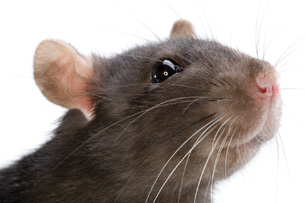
© Oleg Kozlov, Sophy Kozlova/shutterstock
Crossing pure breeding plants or animals with contrasting traits or phenotypes can help demonstrate how dominant and recessive genes work. In this lab you will explore the possible outcomes when parents with contrasting phenotypes for one trait are bred. The lab activity involves completion of a Gizmo on Mouse Genetics (One Trait) and all of the activities indicated in the lab. You will be prompted to complete the Module 6: Lesson 2 Assignment in the lab.
1.10. Page 3
Module 6—Mendelian Genetics: The Transmission of Traits to the Next Generation
 Read
Read
Phenotypically dominant individuals can either be homozygous dominant or heterozygous. There is no way to determine which genotype they have simply by looking at them. To determine the genotype, geneticists conduct test crosses. Recall the information from the video, or read “Test Cross” on page 591 of your textbook. Ensure that you understand how and why a test cross is performed.
 Try This
Try This
TR 9. Writing down crosses and creating Punnett squares is a must for any student of genetics. Using your skills, complete Practice Problem 2 on page 591 and Practice Problem 3 on page 596 of your textbook. Consult with your teacher to clarify your answer and store your work in your course folder.
1.11. Page 4
Module 6—Mendelian Genetics: The Transmission of Traits to the Next Generation
 Reflect and Connect
Reflect and Connect
Study Dictionary or Flash Card Set
Retrieve your genetic dictionary and add all of the new terms from this lesson to your work. Spend a few minutes reviewing and strengthening your grasp of the language of genetics.
You have begun to develop your skills with Punnett squares. Reflect on their usefulness when you are asked to consider traits that are not as simple as contrasting traits, or when more than one trait is considered in the cross. Consider ways that you could adapt the Punnett square to new situations.
 Self-Check
Self-Check
To ensure your understanding of this lesson, answer the following questions.
Use the following information to answer the next question.
Farmers who raise sheep for wool try not to produce offspring with black wool. Black wool is very brittle and difficult to dye; therefore, white wool is more desirable. If a farmer purchases a white ram, he will generally carry out a test cross to determine whether the ram is heterozygous or homozygous for white wool. White wool (W) is dominant to black wool (w).
SC 1. If the ram is heterozygous for white wool, the expected phenotypes of the offspring of the farmer’s test cross would be:
- all black
- all white
- 1/2 black and 1/2 white
- 3/4 black and 1/4 white
Use the following information about tobiano twin colts to answer the next question.
Descriptions and Symbols Used to Represent One Type of Coat Colour in Horses
| 1 | 2 |
3 |
4 |
DNA sequence for coat colour |
TT, Tt |
T |
Tobiano (white spotting pattern) |
|
tt |
t |
Not tobiano (no white spotting pattern) |
SC 2. What are the genotypes for coat colour of two horses that are predicted to produce offspring in a 1:1 genotypic ratio?
- Tt and tt
- Tt and Tt
- Tobiano and tobiano
- Tobiano and not tobiano
sickle cell anemia (SCA): an autosomal recessive disease that causes sickle-shaped red blood cells to form, which get caught in blood vessels, stopping blood flow to tissues
autosomal: refers to a trait that is due to a gene on one of the first 22 pairs of chromosomes—not the sex chromosomes; autosomal traits occur equally in males and females
Use the following information to answer the next question.
Sickle cell anemia is an autosomal recessive genetic disorder. Because individuals affected by sickle cell anemia have defective hemoglobin proteins, their blood cannot transport oxygen properly. There appears to be a relationship between the incidence of malaria and sickle cell anemia. Individuals with sickle cell anemia and carriers of the sickle cell allele have some resistance to malaria. Malaria is caused by the parasite plasmodium, and is transmitted between humans by mosquitoes.
SC 3. The probability of two carrier parents having a child with sickle cell anemia is
- 25%
- 50%
- 75%
- 100%
Use the following information to answer question TR 6.
Cystic fibrosis is the most common genetic disorder among Caucasians, affecting one in 2000 Caucasian children. The cystic fibrosis allele results in the production of sticky mucus in several structures, including the lungs and exocrine glands. Two parents who are unaffected by the disorder can have a child with the disorder.
SC 4. A girl and both her parents are unaffected by the disease. However, her sister is affected by cystic fibrosis. The genotypes of the mother and father are:
- both homozygous
- both heterozygous
- homozygous and heterozygous, respectively
- heterozygous and homozygous, respectively
 Self-Check Answers
Self-Check Answers
SC 1. C
SC 2. A
SC 3. A
SC 4. B
 Try This
Try This
TR 10. One of the essential skills in genetics is learning to apply what you know to new situations. For excellent review material conduct an Internet search using the terms “biology + Arizona + edu + Mendelian genetics + problem sets + monohybrid cross.” Many of the sites available offer help or a tutorial with each question. Complete the questions that are useful to you at this point in your studies.
 Reflect on the Big Picture
Reflect on the Big Picture

© Mikhail Nekrasov/shutterstock
In the Big Picture for this module you were asked to observe the variations in your family. Some people in your family look alike and some do not. Some have inherited certain traits or genetic conditions, and some have not. You have come to understand that some of these characteristics result from the inheritance of simple dominant or recessive alleles for a trait.
A key part to understanding inheritance is being able to determine what traits were present in past generations and predict which are likely to present themselves again in future generations. By learning to use Punnett squares and test crosses, you can determine the alleles present in parents and their offspring. In Lesson 5, you will learn how to apply these skills to determine probabilities and outcomes. For example, you could counsel a young couple on the probability of having a child with cystic fibrosis if you knew their genotypes (cystic fibrosis is a single gene trait). In this lesson, you learned how to conduct tests on plants to see if a strain is true breeding or not, and thus, whether or not it is worth keeping. You will apply the skills of this lesson to developing pedigrees and understanding family histories later in this module.
 Module 6: Lesson 2 Assignment
Module 6: Lesson 2 Assignment
Submit your completed Module 6: Lesson 2 Assignment to your teacher for assessment.
1.12. Page 5
Module 6—Mendelian Genetics: The Transmission of Traits to the Next Generation
 Lesson Summary
Lesson Summary
During this lesson you considered the following focusing questions:
- What are the simple principles of single trait inheritance?
- How can genotype be determined from phenotype?
Mendel worked with seven contrasting traits in peas. Each trait was either dominant or recessive. There was no blending in his work. You have learned that dominant traits will be expressed in either homozygous dominant or heterozygous plants, while recessive traits can only be seen in homozygous recessive plants. You have also learned how to predict the genotypes and phenotypes of offspring using a Punnett square.
Since dominant alleles can hide recessive alleles, breeders and farmers are most interested in working with homozygous or true breeding individuals. This ensures the continuation of desired traits. Since genotypes can not be seen, but only inferred from probabilities, setting up a test cross is an excellent way to determine genotype. In a test cross, an individual with the recessive phenotype is crossed with an individual with unknown genotype displaying the dominant phenotype. The results of the cross will indicate if the unknown was either heterozygous or homozygous. If all resultant offspring express the dominant trait, then the parent of unknown genotype is homozygous dominant. However, if half of the offspring express the recessive trait, then the parent of unknown genotype is heterozygous.
Lesson Glossary
Consult the glossary in the textbook for other definitions that you may need to complete your work.
autosomal: refers to a trait that is due to a gene on one of the first 22 pairs of chromosomes—not the sex chromosomes; autosomal traits occur equally in males and females
monohybrid cross: a cross of two individuals, each of which is heterozygous for one trait (e.g., Tt X Tt; always produces a 1:2:1 genotypic ratio and 3 dominant to 1 recessive phenotypic ratio)
sickle cell anemia (SCA): an autosomal recessive disease that causes sickle-shaped red blood cells to form, which get caught in blood vessels, stopping blood flow to tissues
test cross: a cross done to determine the genotype of an individual with a dominant phenotype; the individual with the unknown genotype is mated with a homozygous recessive individual—if any offspring have the recessive phenotype, the unknown is a heterozygote
1.13. Lesson 3
Module 6—Mendelian Genetics: The Transmission of Traits to the Next Generation
Lesson 3—Multiple Alleles and Incomplete Dominance Crosses

© Anette Linnea Rasmussen/shutterstock
 Get Focused
Get Focused
multiple alleles: some genes have more than two alleles; an order of dominance is given to determine phenotypes from genotypes; e.g., in a particular flower, colour alleles are red, amber, yellow, and albino in order of decreasing dominance
incomplete dominance: some genes have two alleles—neither of which are dominant; in the heterozygote the phenotype is a mixture of both alleles; e.g., if the white and black alleles are incompletely dominant, the heterozygote will be grey
Life is rarely black and white or, in the case of flowers, red and white! Instead, many physical characteristics observed in plants, or in people, have a variety of phenotypes; certainly more than the two phenotypes accounted for by Mendel’s dominant and recessive inheritance pattern.
In this lesson, as your study of genetics becomes more complex, you will discover two more ways that variety can exist. Using monohybrid crosses, you will consider multiple alleles and incomplete dominance. Multiple alleles produce the human blood types A, B, AB, and O. Incomplete dominance is common in the expression of flower colour. By examining these two new inheritance patterns, you will be able to explain some of the variety you see around you. As you explore the increased complexity of inheritance, you will find that Mendel’s laws still apply to inheritance.
In this lesson, you will explore traits that do not follow Mendel’s patterns of simple dominance but that can still be explained by his laws. You will also come to understand how genes can have more than two alternate forms.
In this lesson, the following focusing questions will be examined:
- What happens when one allele is not completely dominant over another?
- How does having more than two alleles for a gene affect the possible phenotypes for a trait?
 Module 6: Lesson 3 Assignment
Module 6: Lesson 3 Assignment
Your teacher-marked Module 6: Lesson 3 Assignment requires you to submit the following:
- a lab on chicken genetics for assessment
Download a copy of the Module 6: Lesson 3 Assignment to your computer now. You will receive further instructions on how to complete this assignment later in the lesson.
As you work through this lesson, remember to add new vocabulary to your flash cards.
The other questions in this lesson are not marked by the teacher; however, you should still answer these questions. The Self-Check and Try This questions are placed in this lesson to help you review important information and build key concepts that may be applied in future lessons.
The key to success in genetics is to practise the opportunities presented in questions.
You should record the answers to all the questions in this lesson and place those answers in your course folder.
While you are completing this lesson, there will be many opportunities for you to acquire, understand, and practise the concepts that are presented to you. As you complete these activities and your summary notes, you will file everything in your course folder to reference when you are preparing for exams.
Remember, you also have the option of trying additional questions from the textbook for further practice. Consult with your teacher for the answers to these questions. The Key will also provide you with many Diploma Exam-style multiple-choice, numerical-response, and written-response questions that will be an excellent review of the module. Practising your responses to these types of questions is good preparation for the Diploma Exam.
1.14. Page 2
Module 6—Mendelian Genetics: The Transmission of Traits to the Next Generation
 Explore
Explore
 Read
Read
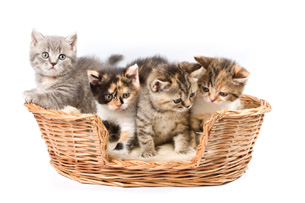
© Utekhina Anna/shutterstock
Pardeep’s tomcat, Smokey, was her pride and joy; dusty grey with chocolate brown spots, he was unique to the neighbourhood. One day, a new family moved in next door. To Pardeep’s surprise they had a female cat, also grey with chocolate spots. When the neighbours discovered Pardeep’s cat, they immediately requested its siring services—they wanted to breed Pardeep's cat to their cat. Ten weeks later, the female gave birth to six kittens. Hopes of the unique grey and chocolate combination were dashed as only one kitten, a male, showed the parental colours. Four kittens were solid grey, and a fifth was completely white.
Why are there three phenotypes in this case instead of only two as in all monohybrid crosses studied so far? What is the explanation for this curious genetic phenomenon that seems to be inconsistent with Mendel's observations?
Read “Incomplete Dominance and Co-dominance” on pages 594 and 595 of your text. Record this information according to your learning style, and then answer the following questions to ensure your understanding. Save the results in your course folder.
TR 1. Four-o'clock flowers occur in two pure-breeding varieties, one with white flowers and the other with red flowers. If these are crossed, all of the F1s have pink flowers. Give the genotype of each parent, and the genotypes of the F1s of such a cross. Use R1 and R2 to represent the alleles for red and white respectively.
TR 2. The phenotype of the F1s is pink flowers that appear to be a blend of the two originals. It is an intermediate type. What is its genotype?
TR 3. How does the phenotypic ratio change for a monohybrid cross with no dominance, as compared to a Mendelian cross where there is dominance?
TR 4. In the case of co-dominance and incomplete dominance, pure-breeding individuals are easily identified. Explain this statement.
TR 5. Use a Punnett square to find the probability of producing a blue roan horse if you cross a roan mare with a black stallion.
TR 6. Can you generally explain the results of breeding Pardeep’s tomcat with the neighbour's spotted cat?
 Watch and Listen
Watch and Listen
Watch the video “Alternate Patterns of Inheritance: the Potential for Diversity” from the beginning to the end of “Incomplete Dominance.” Answer the following questions and share your work with your teacher. Save the results in your course folder.
TR 7. What are multiple alleles?
TR 8. How many alleles can one organism have for a gene with multiple alleles?
TR 9. Define or explain co-dominance.
TR 10. What is incomplete dominance?
TR 11. How do the phenotypic and genotypic ratios compare for an incomplete dominant trait?
 Module 6: Lesson 3 Assignment—Lab
Module 6: Lesson 3 Assignment—Lab
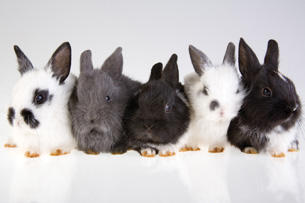
© Ferenc Szelepcsenyi/shutterstock
In the animal kingdom, two phenotypically different parents often produce several different phenotypes in the offspring. A black and a white rabbit can produce many different phenotypes, as shown in the photo. This phenomenon is observed in many livestock, such as cattle and chickens. In this lab, you will breed chickens to study the phenotypes produced from parents of your choice.
Breeding chickens has never been easier! You will complete a Gizmo on Chicken Genetics and all of the activities indicated in the lab. You will be prompted to complete the Module 6: Lesson 3 Assignment as part of the lab.
1.15. Page 3
Module 6—Mendelian Genetics: The Transmission of Traits to the Next Generation
 Read
Read
From his work with peas, Mendel concluded that two factors control every trait, and that each individual has a pair of these factors; one inherited from the mother, and one from the father. One factor is dominant and the other is recessive. As you have just learned with spotting in cats and colours in four-o'clock flowers, exceptions to the dominant/recessive principle exist. Often more than two alleles may affect the same trait.
Carefully read “Multiple Alleles” and “Polygenic Inheritance” pages 604 to 607 in your textbook. Consider the adaptive advantages that multiple alleles might provide. Remember that variety contributes to biodiversity, and biodiversity is the key to the survival of species.
 Try This
Try This
In Biology 20 you examined blood types A, B, AB, and O. In genetics, you have recognized these descriptions to be phenotypes of blood. Now you will examine the genotypes that produce these phenotypes. Examine the sample blood type problems on the top of page 606 of your textbook. Notice how they indicate alleles using a capital I as the letter base, and then add a superscript A or B if indicating one of the co-dominant alleles. A lower case i with no superscript represents the recessive O allele.
TR 12. Complete “Practice Problems” 11, 13 to 15, and 17 on the bottom of page 606 of your textbook. Discuss your work with your teacher and save your answers to your course folder.
 Self-Check
Self-Check
Answer the following questions to check your understanding of the material in this lesson.
SC 1. In short-horned cattle, red is co-dominant with white. The hybrid is called roan. A roan mates with a roan. Use a Punnett square to determine the expected phenotypes of the offspring.
SC 2. The alleles for hair type show incomplete dominance. One allele (c) is for curly hair. Another allele (s) is for straight hair. The hybrid is wavy. A wavy-haired person marries a curly-haired person. Use a Punnett square to determine the expected phenotypes of their children.
SC 3. A rooster with grey feathers is mated with a hen of the same phenotype. Among their offspring, 15 chicks are grey, 6 are black, and 8 are white.
- What is the simplest explanation for the inheritance of these colours in chickens?
- What offspring would you expect from the mating of a grey rooster and a black hen?
SC 4. Colour patterns in a species of duck are determined by one gene with three alleles. Alleles H and I are semi-dominant (i.e., incomplete dominance), and allele i is recessive to both. How many phenotypes are possible in a flock of ducks that contains all of the possible combinations of these three alleles?
 Self-Check Answers
Self-Check Answers
SC 1. CR = red, CW = white, CRCW = roan
Parents: CRCW x CRCW
phenotypes of F1= 1 Red : 2 roan : 1 White
|
CR |
CW |
CR |
CR CR |
CR CW |
CW |
CR CW |
CW CW |
SC 2. HC = curly, HS = straight, HCHS = wavy
Parents: HCHS x HCHS
phenotypes of F1 = 2 wavy : 2 curly
|
HC |
HS |
HC |
HC HC |
HC HS |
HC |
HC HC |
HC HS |
SC 3.
- Incomplete dominance due to the three possible phenotypes
- CB = black, CW = white, CBCW = grey
Offspring= 50% grey: 50% black
|
CB |
CB |
CB |
CB CB |
CB CB |
CW |
CB CW |
CB CW |
SC 4.
Four possible phenotypes:
DHDH, DHDi = H
DIDI, DIDi = I
DHDI = HI
DiDi = i
1.16. Page 4
Module 6—Mendelian Genetics: The Transmission of Traits to the Next Generation
 Reflect and Connect
Reflect and Connect
By adding knowledge of multiple alleles and incomplete dominance to what you have already learned about genetics, you have greatly expanded your ability to interpret phenotypes and predict inheritance. All this and you are still working with only one gene! When each chromosome has hundreds of genes, and humans have 23 chromosome pairs, think of all the possible variations that could exist.
Review your genetics flash cards and add the new terms from this lesson.
 Self-Check
Self-Check
To apply your understanding of this lesson, complete the following Diploma Exam-style questions.
Several geneticists studied M. jalapa plants with deep crimson flowers and M. jalapa plants with yellow flowers. Cross-pollinating these plants produced plants with scarlet-red flowers (F1 generation).
These F1 plants were allowed to self-pollinate, and the resulting seeds produced M. jalapa plants with three different flower colours. Data similar to the following were collected for flower colour:
- 140 deep crimson
- 310 scarlet-red
- 160 yellow
SC 5. With respect to the alleles for flower colour, these results indicate which of the following?
- X-linked inheritance
- gene-linked inheritance
- dominant-recessive inheritance
- incomplete dominance
- inheritance
SC 6. If a woman has blood type A, and her husband has blood type B, which of the following genotypes would be possible for their child with blood type A?
- IAi
- IAIA
- IBIB
- IAIB
SC 7. Which of the following rows indicates the relationship between the IA and IB alleles and the relationship between the IA and i alleles for the blood type gene?
| Row | Relationship between IA and IB |
Relationship between IA and i |
A. |
co-dominant |
co-dominant |
B. |
co-dominant |
dominant-recessive |
C. |
dominant-recessive |
co-dominant |
D. |
dominant-recessive |
dominant-recessive |
SC 8. A dominant allele, XE, carried on the X chromosome, causes the formation of faulty tooth enamel; the resulting enamel being either very thin or very hard. The faulty tooth enamel trait will appear in all of the daughters but none of the sons if the children have a father with which of the following?
- normal tooth enamel and a mother with normal tooth enamel
- normal tooth enamel and mother with faulty tooth enamel
- faulty tooth enamel and a mother with normal tooth enamel
- faulty tooth enamel and a mother with faulty tooth enamel
Use the following information to answer SC 9.
Cat coat colour results from the interaction of three different genes. A gene for black-based colours is located on an autosomal chromosome. A gene for red-based colours is located on the X chromosome. A different gene located on a separate autosomal chromosome determines pigment density in cat hair.
The black based gene has three possible alleles: B-black, b-chocolate and bI-cinnamon. If pigmentation in cat hair is dense, the phenotypes listed below are possible.
| Genotype | Phenotype |
| BB, Bb, BbI | Black |
| bb, bbI | Chocolate |
| bIbI | Cinnamon |
SC 9. According to the data above, the relationship among these alleles is such that the
- black allele is co-dominant with the chocolate and cinnamon alleles
- black allele is co-dominant with the chocolate allele, and the chocolate allele is co-dominant with the cinnamon allele
- black allele is dominant over the chocolate and cinnamon alleles, and the chocolate allele is dominant over the cinnamon allele
- black allele is dominant over the chocolate and cinnamon alleles, and the chocolate and cinnamon alleles are co-dominant
 Self-Check Answers
Self-Check Answers
SC 5. D
SC 6. A
SC 7. B
SC 8. C
SC 9. C
 Try This
Try This
TR 13. One of the essential skills in genetics is learning to apply what you know to new situations. For excellent review material, conduct a web search using the terms “biology + Arizona + edu + Mendelian genetics + problem sets + monohybrid cross.” Many of the sites available offer help or tutorial with each question. Complete the additional questions involving multiple alleles and incomplete dominance that are useful to you at this point in your studies.
 Reflect on the Big Picture
Reflect on the Big Picture

© btrenkel/iStockphoto
In the Big Picture section, you may have wondered why some people in your family are alike and some are not. Your parents may be Type A and Type B blood. Your sister is also type A, but you are Type O. From your work in this lesson you should understand how multiple alleles can increase the variation in phenotypes in individuals.
Understanding blood types and their inheritance pattern can go a long way when working with family histories, developing pedigrees, and determining paternity. In Biology 20 you learned about the four phenotypes of blood and what can happen if a person receives incompatible blood. In this lesson you examined the three alleles for blood type and how they account for the four possible phenotypes. Using this information, you can predict possible blood types of future children, study family pedigrees to determine lineage, and even determine if there was a mix-up of babies in the hospital!
pedigrees: a chart outlining the generations and relationships within a family line
 Module 6: Lesson 3 Assignment
Module 6: Lesson 3 Assignment
Submit your completed Module 6: Lesson 3 Assignment to your teacher for assessment.
1.17. Page 5
Module 6—Mendelian Genetics: The Transmission of Traits to the Next Generation
 Lesson Summary
Lesson Summary
In this lesson you examined the following focusing questions:
- What happens when one allele is not completely dominant over another?
- How does having more than two alleles for a gene affect the possible phenotypes for a trait?
In cases where one allele is not completely dominant over another, each allele is somewhat expressed. If the heterozygous phenotype appears to be more of a blend, as with flower colour, this is called incomplete dominance. Co-dominance is when each allele is fully expressed in different parts, like with black and white hairs in roan horses.
When multiple alleles are present for a trait there will be many possible phenotypes. Each individual still has only two alleles, but there may be many possible combinations for these two alleles in the population as a whole. Each allele set can still be analyzed with the patterns we’ve learned. One allele will either be dominant over the other, or it will be incompletely dominant. With many alleles, this may lead to an order of dominance, which you will examine in Lesson 8.
Lesson Glossary
Consult the glossary in the textbook for other definitions that you may need to complete your work.
biodiversity: the variation present in the genes, species, and ecosystems of a biome; at the species level refers to the variety of alleles, genotypes, and phenotypes present for each gene; used as an indicator of the biological health of a species, ecosystem, or biome
co-dominance: similar to incomplete dominance—neither allele is dominant; in the heterozygote, both distinct phenotypes appear—not a mixture (e.g., red and white cow colour alleles produce red and white hairs in the heterozygote; in blood types the AB heterozygote makes both A antigens and B antigens—not a mixture)
incomplete dominance: some genes have two alleles—neither of which are dominant; in the heterozygote the phenotype is a mixture of both alleles (e.g., if the white and black alleles are incompletely dominant, the heterozygote will be grey)
multiple alleles: some genes have more than two alleles; an order of dominance is given to determine phenotypes from genotypes (e.g., in a particular flower, colour alleles are red, amber, yellow, and albino in order of decreasing dominance)
pedigree: a chart outlining the generations and relationships within a family line
1.18. Lesson 4
Module 6—Mendelian Genetics: The Transmission of Traits to the Next Generation
Lesson 4—Dihybrid Crosses

© TimmyQ/shutterstock
 Get Focused
Get Focused
Working with one gene at a time is like playing catch. It takes a few tosses in the back yard with your mom, dad, or an older sibling, but after a bit of practice, it becomes second nature. Working with two or more genes is like juggling—more balls to keep track of, but the basic concepts are the same. All of the inheritance types you have studied still apply, but now you will apply the principles to two genes, each with their own alleles. The total movement is trickier, and the process might take a bit more practice. This lesson may take you a little longer to complete, but the practice that you do will lead to success in your study of genetics.
In this lesson, you will learn how to follow the inheritance of two separate traits at the same time. You will appreciate how the movement of alleles for one trait does not effect the movement of alleles for the other trait during the formation of gametes.
In this lesson, the following focusing question will be examined:
- How do scientists track the inheritance of more than one trait at a time?
 Module 6: Lesson 4 Assignment
Module 6: Lesson 4 Assignment
Your teacher-marked Module 6: Lesson 4 Assignment requires you to submit the following:
- a lab on mouse genetics (two traits) for assessment.
Download a copy of the Module 6: Lesson 4 Assignment to your computer now. You will receive further instructions on how to complete this assignment later in the lesson.
Continue to develop your flash cards. In this lesson you may find that examples of Punnett squares are a useful illustration of your definition.
You must decide what to do with the questions that are not marked by the teacher.
Remember that these questions provide you with the practice and feedback that you need to successfully complete this course. You should record the answers to all of the questions in this lesson and place those answers in your course folder.
Remember you also have the option of trying additional questions from the textbook for further practice. Consult with your teacher for the answers to these questions. The Key will also provide you with many Diploma Exam-style multiple-choice, numerical-response, and written-response questions that will be an excellent review of the module. Practising your responses to these types of questions is good preparation for the Diploma Exam.
1.19. Page 2
Module 6—Mendelian Genetics: The Transmission of Traits to the Next Generation
 Explore
Explore
 Read
Read
dihybrid: a genotype that is heterozygous for two traits, for example AaBb; sometimes used in a general way to refer to genetics problems using two traits
trihybrid: a genotype that is heterozygous for three traits, for example AaBbCc; sometimes used in a general way to refer to genetics problems using three traits
law of independent assortment: during meiosis, any allele from one trait can end up in the same gamete with any allele from another trait; e.g., an individual with the DdGg genotype can produce DG, Dg, dG, or dg gametes; only applies to genes that are not linked on the same chromosome
Mendel was interested in determining whether the movement of one trait’s alleles affected the movement of another trait’s alleles. To test this out, Mendel conducted crosses between plants that were true breeding for two traits. When a cross is carried out to observe two traits at the same time, it is called a dihybrid cross. If three traits were being analyzed at once, it would be a trihybrid cross.
One of the most important discoveries Mendel made when conducting dihybrid crosses was the discovery that the movement of alleles for different genes did not affect each other. This led Mendel to propose his second law: the Law of Independent Assortment. Read “The Law of Independent Assortment” and how to develop a 16-square Punnett square to track dihybrid crosses on pages 591 to 593 of your textbook.
 Watch and Listen
Watch and Listen
Watch the video “Classical Genetics and Dihybrid Crosses.” You may choose to watch the entire video, or, using the navigation bar on the right edge of the video, start watching the section titled “Objectives.” Continue to watch until the end of “Bio Simulation: Mendel’s Dihybrid Cross.” To master the concepts, answer the following Try This questions and save your work in your course folder.
TR 1. What was the letter assignment used here for widow’s peak/straight hairline, and for normal thumb/hitchhiker’s thumb?
TR 2. What hypothesis (if/then statement) did the students create to test whether the attachment of earlobes was a trait controlled by a dominant or recessive allele?
TR 3. Did the students find many people with all three traits recessive?
TR 4. In your own words, state or explain Mendel’s second law, the law of independent assortment.
TR 5. Starting with parents that are true breeding for two independent traits, what will be the resulting phenotypic ratio in the F2 generation for each of the following?
- dom/dom
- dom/rec
- rec/dom
- rec/rec
TR 6. Does the movement of the alleles for plant height affect the movement of the alleles for flower colour?
 Try This
Try This
Review again how to create gametes from parents, and then how to build a 16-square Punnett square by examining “Figure 17.10” on page 593 of your text. If you are still unsure about how the gametes fill in the square, ask your teacher to suggest questions from the textbook that you could practise, or you may choose to search the Internet for dihybrid tutorials.
TR 7. Answer question 6 on page 598 of your textbook. Use a Punnett square to find all of the genotypes and phenotypes in part (b). Save your answers to your course folder.
For additional resources, you may go to the McGraw-Hill Ryerson online learning centre. On this website are many resources for practising and for testing yourself.
 Watch and Listen
Watch and Listen
Think back to the video “Classical Genetics and Dihybrid Crosses.” Mastering dihybrid crosses and Punnett Squares is an essential skill in Biology 30. Ensure your mastery by answering the following questions. If you have difficulty with these questions, you may choose to review the video or consult with your teacher.
TR 8. Did the parental alleles remain together when the F1 generation self crossed, or did they separate?
TR 9. What is the F2 ratio of phenotypes in Mendel’s dihybrid crosses?
TR 10. How many different gametes can be formed from AaBbCc?
 Module 6: Lesson 4 Assignment—Labs
Module 6: Lesson 4 Assignment—Labs
In previous lessons, you tracked the movement of alleles for one gene, such as plant height. In this lesson you have been introduced to the independent movement of four alleles; two for each separate gene, such as plant height and seed colour.
In this lab simulation, you will practise tracing dihybrid traits in a Punnett Square and you will examine ratios in the offspring that help you understand the genotypes of the parents.
You will complete a Gizmo on Mouse Genetics (Two Traits) and all of the activities indicated in the lab. You will be prompted to complete the Module 6: Lesson 4 Assignment as part of the lab.
1.20. Page 3
Module 6—Mendelian Genetics: The Transmission of Traits to the Next Generation
 Self-Check
Self-Check
Answer the following questions to check your understanding of the material in this lesson.
SC 1. In pepper plants, green (G) fruit colour is dominant to red (g) fruit colour, and round (R) fruit shape is dominant to square (r) fruit shape. These two genes are located on different chromosomes.
- What gamete types will be produced by a heterozygous green, round plant?
- If two such heterozygous plants are crossed, what genotypes and phenotypes will be seen in the offspring, and in what proportions?
SC 2. In watermelons, the genes for green colour and for short shape are dominant over the alleles for striped colour and for long shape. Suppose a plant with long, striped fruit is crossed with a plant that is heterozygous for green colour and homozygous for short shape. What is the phenotype of their offspring? (Be sure to show all your work).
SC 3. In humans, a cleft chin is due to a dominant allele (D), while the recessive allele (d) produces no cleft. Most people have free earlobes due to a dominant allele (E), and a person with attached ear lobes has two recessive alleles (e). If a mother is homozygous for cleft chin and heterozygous for free earlobes, and the father is heterozygous for both traits, determine the following:
- What is the probability that their baby will have the following combinations?
- a cleft chin and attached ear lobes
- a cleft chin and free ear lobes
- no cleft chin and free ear lobes
- no cleft chin and attached ear lobes
- Draw a Punnett square to support your answer.
SC 4. The allele for black coat colour (B) is dominant over the allele for white coat colour (b) in dogs. The allele for short hair (S) is dominant over the allele for long hair (s). The phenotypes of offspring from several crosses are given below.
Cross |
Parental Phenotypes |
Phenotypes of Offspring |
|||
Black, Short |
Black, Long |
White, Short |
White, Long |
||
1 |
black, short x black, long |
16 |
15 |
0 |
0 |
2 |
white, short x white, short |
0 |
0 |
27 |
8 |
3 |
black, short x black, long |
6 |
5 |
3 |
2 |
4 |
black, long x black, long |
0 |
31 |
0 |
10 |
Answer the following questions using the information provided in the table above.
- What are the genotypes for parents of each of the four crosses?
- If the black coat colour and long hair offspring from Cross 3 is crossed with the black coat colour and short hair offspring from Cross 1 (assume both parents are BB), what proportion of the offspring will have black, short hair? Is it possible to have offspring with white, long hair from this cross?
 Self-Check Answers
Self-Check Answers
SC 1.
- The green round plant will produce GR, Gr, gR, and gr gametes in equal proportion since the genes are unlinked.
- This will give
 green round,
green round,  green square,
green square,  red round, and
red round, and  red square phenotypes; the genotypes are given in the Punnett square below.
red square phenotypes; the genotypes are given in the Punnett square below.
GR Gr gR gr GR GR GR GR Gr GR gR GR gr Gr Gr GR Gr Gr Gr gR Gr gr gR gR GR gR Gr gR gR gR gr gr gr GR gr Gr gr gR gr gr
SC 2.
Allele assignment: G = green, g = stripped, S = short, s = long.
Parents: ggss x GgSS
Gametes: [gs] x [GS], [gS]
Offspring: GgSs, ggSs
Phenotype: 50% green short : 50% striped short
SC 3. Parents: DDEe x DdEe
Gametes: [DE], [De] x [DE], [De], [dE], [de]
a.


- 0
- 0
b.
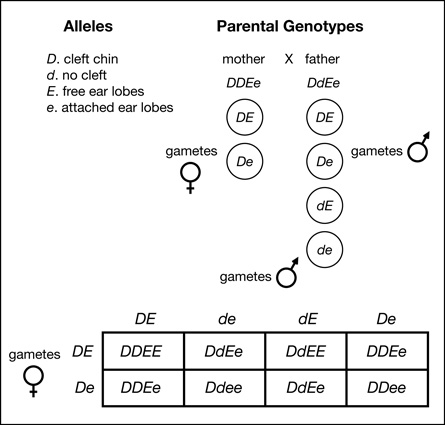
SC 4.
- Cross 1: BBSs x BBss Cross 2: bbSs x bbSs
Cross 3: BbSs x Bbss Cross 4: Bbss x Bbss
- Offspring with black, short hair:
 or 50%
or 50%
It is not possible to have offspring with white, long hair since the only colour allele present is B.
1.21. Page 4
Module 6—Mendelian Genetics: The Transmission of Traits to the Next Generation
 Reflect and Connect
Reflect and Connect
This lesson has helped you to understand how to track two traits at the same time, while still following all of the inheritance patterns you have already learned. Complete the following Self-Check to apply all of the principles that you have been mastering.
 Self-Check
Self-Check
In tomato plants, purple stems (P) are dominant to green stems (p), and red tomatoes (T) are dominant to yellow tomatoes (t). The two genes are located on separate chromosomes.
A purple-stemmed, red-tomato plant is crossed with a purple-stemmed, yellow-tomato plant. They produce the following:
- 28 purple-stemmed, red-tomato plants
- 31 purple-stemmed, yellow-tomato plants
- 11 green-stemmed, red-tomato plants
- 9 green-stemmed, yellow-tomato plants
SC 6. The genetic compositions of the parents are as follows:
- PpTt and PPTT
- PPTt and PpTT
- PpTt and PpTt
- PpTt and Pptt
SC 7. One of the green-stemmed, red-tomato plants was crossed with another tomato plant. One of the offspring was a purple-stemmed, yellow-tomato plant. If this offspring were crossed with a green-stemmed, yellow-tomato plant, then the possible phenotype(s) of the offspring would be as follows:
- green-stemmed, yellow-tomato plants
- green-stemmed, yellow-tomato plants and purple-stemmed, yellow-tomato plants
- green-stemmed, yellow-tomato plants; purple-stemmed, yellow-tomato plants; and purple-stemmed, red-tomato plants
- green-stemmed, yellow-tomato plants; purple-stemmed, yellow-tomato plants; purple-stemmed, red-tomato plants; and green-stemmed, red-tomato plants
Use the following information to answer SC 8.
Gregor Mendel examined the inheritance of two traits in pea plants: seed coat texture and colour. Seed coat texture can be represented as S–smooth, or s–wrinkled, and seed coat colour can be represented as Y–yellow, or y–green. SSYY plants were crossed with ssyy plants to yield F1 pea seeds that were all smooth and all yellow. By crossing plants grown from these F1 seeds, Mendel obtained four different phenotypes of F2 seeds:
- smooth, green seeds
- wrinkled, green seeds
- smooth, yellow seeds
- wrinkled, yellow seeds
Numerical Response
SC 8. What would the F2 seed phenotype ratio that Mendel obtained upon crossing two heterozygous smooth, yellow F1 individuals have been? List the ratio in the following order:
smooth green : wrinkled green : smooth yellow : wrinkled yellow.
Use the following additional information to answer SC 9.
Mendel selected two varieties of pea plants from seeds he had grown. One variety of peas came from a field planted with smooth, yellow seeds. Another variety of peas came from a field planted with wrinkled, green seeds. These two varieties of peas were crossed to produce the following:
- 255 plants with smooth, green seeds
- 268 plants with wrinkled. green seeds
- 237 plants with smooth, yellow seeds
- 240 plants with wrinkled, yellow seeds
From the phenotype ratio of the offspring, Mendel deduced that the smooth and yellow parents had the genotype YySs.
SC 9. This type of cross is referred to as which of the following:
- test cross
- monohybrid cross
- homozygous cross
- heterozygous cross
Use the following information to answer SC 10.
In pea plants, tall (T) is dominant over short (t), and round seed (R) is dominant over wrinkled seed (r). The Punnett square below shows a cross between a heterozygous, tall–heterozygous, round-seed pea plant and a short–heterozygous, round-seed pea plant. Different types of offspring are represented by numbers.
|
TR |
Tr |
tR |
tr |
tR |
1 |
2 |
3 |
4 |
tr |
5 |
6 |
7 |
8 |
SC 10. Which two types of offspring are pure breeders for both plant height and seed shape?
- 1 and 6
- 2 and 5
- 3 and 8
- 4 and 7
 Self-Check Answers
Self-Check Answers
SC 6. C
SC 7. B
SC 8. 9, 3, 3, 1
SC 9. A
SC 10. C
 Reflect on the Big Picture
Reflect on the Big Picture

© Franz Pfluegl/shutterstock
In the Big Picture you wondered why you have your mother’s eyes but not her nearsightedness. What might cause certain traits to be inherited not others?
In this lesson, you learned to work with more than one gene. This allows you to be more efficient when working with inheritance problems. By working with more than one gene, you are able to see how traits on different chromosomes assort independently when creating gametes. Because these traits are on different chromosomes, like the figures on the different puzzle pieces of the picture, they have no effect on each other when being passed on to the next generation. For example, pea shape does not move with pea colour, and shape doesn’t affect colour. You have the gene for your mother’s eye colour because you inherited that chromosome from her egg, but the chromosome with the gene for nearsightedness did not become part of the egg from which you developed. These chromosomes assorted independently.

© Franz Pfluegl/shutterstock
How would traits be passed on to the next generation if they were on the same chromosome? How would the movement of these figures be different now that the puzzle pieces are together? Mendel did not study such traits, but in later lessons, you will look at traits that tend to move together because they are on the same chromosome.
 Module 6: Lesson 4 Assignment
Module 6: Lesson 4 Assignment
Before you complete your assignment for Lesson 4, you may wish to complete Lesson 5, which examines how to calculate probability. Some of the questions in the Lesson 4 assignment require that you complete probability calculations.
When complete, submit your completed Module 6: Lesson 4 Assignment to your teacher for assessment.
1.22. Page 5
Module 6—Mendelian Genetics: The Transmission of Traits to the Next Generation
 Lesson Summary
Lesson Summary
During this lesson you were to consider the following focusing question:
- How do scientists track the inheritance of more than one trait at a time?
By learning Mendel’s law of independent assortment and how to build dihybrid Punnett squares, you can now follow the movement of two traits on different chromosomes at once. You have studied how the movement of alleles for one trait does not affect the movement of alleles for the other trait during the formation of gametes. You have learned to apply the principles of genetics to the study of two genes, each with their own alleles.
Lesson Glossary
Consult the glossary in the textbook for other definitions that you may need to complete your work.
dihybrid: a genotype that is heterozygous for two traits, for example AaBb; sometimes used in a general way to refer to genetics problems using two traits
law of independent assortment: during meiosis, any allele from one trait can end up in the same gamete with any allele from another trait (e.g., an individual with the DdGg genotype can produce DG, Dg, dG, or dg gametes; only applies to genes that are not linked on the same chromosome)
phenotypic ratio: a proportion expressing all the possible visible physical traits in a generation
trihybrid: a genotype that is heterozygous for three traits, for example AaBbCc; sometimes used in a general way to refer to genetics problems using three traits
1.23. Lesson 5
Module 6—Mendelian Genetics: The Transmission of Traits to the Next Generation
Lesson 5—Probability

© James Steidl/shutterstock
 Get Focused
Get Focused
Genetics involves predicting outcomes. Just like tossing a coin to decide who kicks the football, there is always a certain amount of chance in genetic outcomes. Still, the players at the game know that there are only two possible outcomes, and the likelihood of either one is 50%.
By reviewing how probabilities of traits work together, and by learning the product or addition rule, you will be able to more reliably predict how a trait, or traits, should move from generation to generation.
probability: the likelihood of an event occurring; can be expressed as a decimal (0.20), fraction (![]() ), or percentage
), or percentage
(20%).
product: to multiply
addition: to add or sum
In this lesson, you will learn how to predict the genetic outcome of future generations by examining numbers and ratios. Patterns can give the likelihood of a trait remaining hidden or being expressed.
In this lesson, the following focusing question will be examined:
- How can ratios be used to analyze types of inheritance or to predict the possibility of a trait appearing in the next generation?
 Module 6: Lesson 5 Assignment
Module 6: Lesson 5 Assignment
Your teacher-marked Module 6: Lesson 5 Assignment requires you to submit a response to the following:
- a lab on calculating probability
Download a copy of the Module 6: Lesson 5 Assignment to your computer now. You will receive further instructions on how to complete this assignment later in the lesson.
There will be a few concepts and examples for you to add to your flash cards in this lesson.
You must decide what to do with the questions that are not marked by the teacher.
Remember that these questions provide you with the practice and feedback that you need to successfully complete this course. You should record the answers to all of the questions and place those answers in your course folder.
Remember, you also have the option of trying additional questions from the textbook for further practice. Consult with your teacher for the answers to these questions. The Key will also provide you with many Diploma Exam-style multiple-choice, numerical-response, and written-response questions that will be an excellent review of the module. Practising your responses to these types of questions is good preparation for the Diploma Exam.
Materials
- a small cup
- pencil and paper
- two coins of the same denomination
1.24. Page 2
Module 6—Mendelian Genetics: The Transmission of Traits to the Next Generation
 Explore
Explore
 Read
Read

© Chistoprudov Dmitriy Gennadievich/shutterstock
Probabilities are usually expressed as real numbers with values from zero to one, for example 0.00–1.00. You may also express probabilities as fractions or percentages. A probability of zero means “no chance,” while a probability of one means it’s a “sure thing.” Anywhere in between, the chance will differ; low values indicate it is unlikely, high values indicate it is likely. There are two general rules when considering probability. They are the rules of addition and product. Deciding when to use which rule depends on whether the probabilities are linked or independent.
Addition Rule
If two outcomes are mutually exclusive (you can have one but not the other), the probability that either will occur is their sum.
Dice Example
- The probability that you will roll a 3 on a single die is
 (6 for the 6 sides, or possibilities).
(6 for the 6 sides, or possibilities).
- The probability that you will roll a 4 is the same (
 ).
).
- Thus, the probability that you will roll either a 3 or a 4 is
 +
+  =
=  or
or  , or o.33, or 33%.
, or o.33, or 33%.
Having many exclusive outcomes makes the likelihood, or probability, increase.
Multiplication Rule
If two outcomes are independent (not linked), the probability that both will occur is their product.
Dice Example
- The probability that you will roll a 6 on a single die is
 , and the probability that you will roll a 6 on a second die is the same.
, and the probability that you will roll a 6 on a second die is the same.
- However, the probability that you will roll two sixes on a pair of dice (at once) is
 x
x  =
=  , or 0.03, or 3%.
, or 0.03, or 3%.
Having many independent outcomes occur at once makes the likelihood, or probability, decrease.
Example
What is the probability of three coin tosses coming up heads, tails, and tails?
Which rules will be applied?
- The multiplication rule will be applied.
How will it be applied?
- Take the probability of the first event, times the second, times the third.
So what is the probability of heads, tails, tails in a coin toss?
- (
 ) x (
) x ( ) x (
) x ( ) =
) =  chance or 0.125 or 12.5%
chance or 0.125 or 12.5%
Note: Probability questions are common numerical response questions on your Diploma Exam. There isn’t an opportunity to record numerical responses as fractions, but the question can request your answer as a decimal, or as a percent. Read the question carefully—there’s a big difference in recording 0.125 or 12.5% in a machine-scored response.
 Watch and Listen
Watch and Listen
Return to the video on Classical Genetics and Dihybrid Crosses. Using the navigation bar on the right edge of the video, start watching the section titled “Bio Bit: Dihybrid Crosses in Canaries.” Continue viewing until the end of the video. Answer the following questions and save your work in your course folder. You may consult with your teacher to verify your answers.
TR 1. What is the probability of rolling a 3 on one die?
TR 2. What does the sum of all possibilities equal?
TR 3. What is the probability of rolling a 6 on two different dice at the same time? To figure this out, what “rule” did you need to use?
TR 4. How can you use this rule and two smaller Punnett squares to predict the offspring of a dihybrid cross?
TR 5. If you assume that the parents are heterozygous for all three traits in the film, what is the probability of having a child with widow’s peak, hitchhiker’s thumb, and free earlobes?
 Lesson 5 Lab—Calculating Probability
Lesson 5 Lab—Calculating Probability
Probability can be defined as a study of the chance that certain events or phenomena will happen. In this lab, you will explore how probabilities with coin tosses can be either linked or not linked. You will then draw connections between the outcomes of coin tosses with the outcomes of genetic crosses.
Complete the lab and activities on calculating probability. You will then be prompted to complete the Module 6: Lesson 4 Assignment as part of the lab.
1.25. Page 3
Module 6—Mendelian Genetics: The Transmission of Traits to the Next Generation
 Self-Check
Self-Check
To practise “probabilities,” complete the following questions. The questions allow you to express your answer as a fraction, a decimal, or a percentage. Remember to read the question on the Diploma Exam carefully. It will specifically state the format that your answer must take.
SC 1. The ability to taste the chemical PTC is determined by a single gene in humans, with the ability to taste PTC indicated by the dominant allele T, and the inability to taste PTC by the recessive allele t. Suppose two heterozygous tasters (Tt) have a large family.
- Predict the proportion of their children who will be tasters and non-tasters. Use a Punnett square to illustrate how you made this prediction.
- What is the likelihood that their first child will be a taster? What is the likelihood that their fourth child will be a taster?
- What is the likelihood that the first three children of this couple will be non-tasters?
SC 2. A husband and wife are both heterozygous for a recessive gene, c, for albinism. They were informed that the twins they are expecting are dizygotic, a boy and a girl.
- Draw a Punnett square of this cross.
- What are the chances that one child will be albino?
- What are the chances that both children will be normal?
- What are the chances that both babies will have the same phenotype for skin pigmentation?
 Self-Check Answers
Self-Check Answers
SC 1.
- Parents: Tt x Tt
Gametes: [T], [t] x [T], [t]
|
T |
t |
T |
TT |
Tt |
t |
tT |
tt |
![]() TT +
TT + ![]() Tt =
Tt = ![]() tasters
tasters
![]() tt =
tt = ![]() non-tasters
non-tasters
- 1st child—

4th child— (each child is independent)
(each child is independent)
These are not linked.
- Here they are linked probabilities, so the multiplication rule is used.
 for each child;
for each child;  that all three will be non-tasters.
that all three will be non-tasters.
SC 2.
|
C |
c |
C |
CC |
Cc |
c |
Cc |
cc |
 or 25% or 0.25
or 25% or 0.25
 ; this is the multiplication rule.
; this is the multiplication rule.
- First:
 for two albinos
for two albinos
Next: for two normal
for two normal
Then: for either
for either
1.26. Page 4
Module 6—Mendelian Genetics: The Transmission of Traits to the Next Generation
 Reflect and Connect
Reflect and Connect
By conducting the lab on coin tosses you should have been able to make the connection between probabilities in genetics and everyday events. It takes some practice, but probabilities can help solve genetics problems faster than writing out complete Punnett squares. To practice your skills, complete the following questions and check your answers. If you are encountering any difficulty, consult with your teacher.
In Unit A, Module 2, you were introduced to Emily, who suffered from familial multiple endocrine neoplasia type 1 (FMEN1). Her career goals and life plans were continually interrupted by her health issues involving her endocrine system. In this module you have come to understand how Emily inherited this disorder. You can reflect on why she and her husband have decided not to have a family knowing that Emily’s condition is autosomal dominant. Apply your knowledge of probability to explain how Emily has a 50% chance of passing the gene to her children.
To apply your understanding of probability, complete the following Self-Check questions.
 Self-Check
Self-Check
Numerical Response
SC 3. A dominant allele, XE, carried on the X chromosome, causes the formation of faulty tooth enamel, resulting in either very thin or very hard enamel. A woman heterozygous for faulty tooth enamel marries a man with normal tooth enamel. What is the probability that their first child will be a boy with normal tooth enamel?
Numerical Response
SC 4. In sheep, white wool is a dominant trait, and black wool is a recessive trait. In a herd of 500 sheep, 20 sheep have black wool. If two heterozygous sheep mated, what would be the probability of them having a white lamb?
Numerical Response
Use the following information to answer SC 5.
Cystic fibrosis is the most common genetic disorder among Caucasians, affecting one in 2000 Caucasian children. The cystic fibrosis allele results in the production of sticky mucus in several structures, including the lungs and exocrine glands. Two parents who are unaffected by the disorder can have a child with the disorder.
SC 5. These parents, who are unaffected by cystic fibrosis, are planning to have another child. What is the percentage probability that their next child will be affected by cystic fibrosis? (Record your answer as a whole number.)
Numerical Response
Use the following information to answer SC 6.
Marfan syndrome is an autosomal-dominant disorder of humans. Affected individuals tend to be tall and thin. They have defects in the lens of the eye, and weak connective tissue around the aorta. Often, affected individuals excel in sports like volleyball or basketball, but it is not uncommon for people with this syndrome to die suddenly.
SC 6. A man, heterozygous for Marfan syndrome, and a homozygous recessive woman have a child. What is the probability that the child will be affected by Marfan syndrome? (Record your answer as a value from 0 to 1, rounded to two decimal places.)
Use the following information to answer SC 7.
Scientists believe that a mutant form of an autosomal gene called BRCA1 may be associated with 5% to 10% of all cases of breast cancer. About 80% of women who inherit the gene in its defective form are likely to develop a cancerous breast tumor. Men who carry the faulty BRCA1 gene rarely develop breast cancer, but they may pass the gene to their offspring.
SC 7. A couple has two children, a girl and a boy. The mother has a single mutant gene for breast cancer; the father is not a carrier of the mutant BRCA1 gene.
What is the probability that their daughter has inherited the mutant BRCA1 gene?
- 75%
- 50%
- 25%
- 0%
 Self-Check Answers
Self-Check Answers
SC 3. 0.25 or ![]()
SC 4. 0.75 or ![]()
SC 5. 25% or ![]()
SC 6. 0.50 or ![]()
SC 7. C
 Reflect on the Big Picture
Reflect on the Big Picture
From the Big Picture, were you worried that you would become bald too if all the men in your family were balding? You noticed the variety of traits in your family. Now you appreciate how you might calculate your chances of inheriting those traits.
Using mathematical calculations to generate probabilities can help to predict the outcomes of various crosses quickly and accurately. However, doing so can be a real challenge for some students. If you found working with probabilities difficult, remember that you can also solve these kinds or problems by creating Punnett squares and carefully filling them in as you did in Lesson 4. You should now have a basic understanding of probabilities, which will enable you to easily report chances in the form of fractions, decimals, or percentages.
 Module 6: Lesson 5 Assignment
Module 6: Lesson 5 Assignment
Submit your completed Module 6: Lesson 5 Assignment to your teacher for assessment.
1.27. Page 5
Module 6—Mendelian Genetics: The Transmission of Traits to the Next Generation
 Lesson Summary
Lesson Summary
During this lesson, you were to consider the following focusing question:
- How can ratios be used to analyze types of inheritance or to predict the possibility of a trait appearing in the next generation?
Through the practice questions and the coin toss lab, you have been given the opportunity to practise determining ratios. In the next lesson, you will use ratios to analyze the types of inheritance, such as sex-linked characteristics. By adding or multiplying the probabilities of individual traits, you have been able to predict the possible phenotypic outcomes of the next generation for two or three different traits. This can help answer genetic problems much more quickly than drawing out large Punnett squares.
Lesson Glossary
Consult the glossary in the textbook for other definitions that you may need to complete your work.
addition: to add or sum
probability: the likelihood of an event occurring; can be expressed as a decimal (0.20), fraction (![]() ), or percentage
), or percentage
product: to multiply
1.28. Lesson 6
Module 6—Mendelian Genetics: The Transmission of Traits to the Next Generation
Lesson 6—Chromosomal Theory and Sex-linked Inheritance
 Get Focused
Get Focused

© 2008 Jupiterimages Corporation
Genetics, it seems, does not always play equally with each gender. Have you ever noticed that there are quite a few more balding men than balding women? Perhaps you know of someone who is colour-blind. If you do, it is far more likely that the person you know is male instead of female. Each of these examples indicates that there is more going on than independent assortment. There appears to be a link between the appearance of certain traits and gender.
In this lesson, you will begin to explore inheritance patterns that do not follow all of Mendel’s laws of inheritance. You will see how some traits occur more frequently in one gender than the other, and are said to be sex-linked.
In this lesson, the following focusing questions will be examined:
- Why do some traits appear more frequently in one gender than the other?
- How did Thomas Hunt Morgan’s work create experimental support for the chromosomal theory of inheritance?
sex-linked: a trait that is found in one gender more than another; contrary to autosomal traits that are found equally in both genders
chromosomal theory of inheritance: the theory that chromosomes are strings of genes and that each gene has a specific location on a specific chromosome
 Module 6: Lesson 6 Assignment
Module 6: Lesson 6 Assignment
Your teacher-marked Module 6: Lesson 6 Assignment requires you to submit a response to the following:
- a lab on sex-linked traits in Drosophila
Your work from this lab will be added to your assignment for assessment. Download a copy of the Module 6: Lesson 6 Assignment to your computer now. You will receive further instructions on how to complete this assignment later in the lesson.
Remember to add new terms and concepts to your flash cards as you work through this lesson.
You must decide what to do with the questions that are not marked by the teacher.
Remember that these questions provide you with the practice and feedback that you need to successfully complete this course. You should record the answers to all of the questions and place those answers in your course folder.
Remember, you also have the option of trying additional questions from the textbook for further practice. Consult with your teacher for the answers to these questions. The Key will also provide you with many Diploma Exam-style multiple-choice, numerical-response, and written-response questions that will be an excellent review of the module. Practising your responses to these types of questions is good preparation for the Diploma Exam.
1.29. Page 2
Module 6—Mendelian Genetics: The Transmission of Traits to the Next Generation
 Explore
Explore
 Read
Read
Chromosome Theory of Inheritance
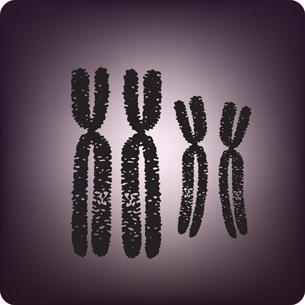
© attem/shutterstock
Before considering how certain traits are linked to gender, recall two of Mendel’s laws. His first law explains how parents have two alleles for a trait, and that these alleles separate during the formation of gametes. As a result, gametes have only one allele for each trait. For example, if the parent is heterozygous for height, Tt, then one gamete could receive the allele T for tall, and the other gamete receives the allele t for short.
Mendel's second law explains how two or more allele pairs segregate independently from one another into gametes. As a result, the inheritance of one characteristic can have little relationship to the inheritance of a different characteristic. For example, the allele for height segregates independently and has no affect on the colour of the seed, or the texture of the seed, or the colour of the flower.
In Module 5, you learned that when diploid organisms go through meiosis, homologous pairs of chromosomes are separated during the formation of gametes. Therefore, for each pair of gametes produced, each of the two gametes has only one homologous chromosome. In meiosis I, during metaphase I, each pair of homologous chromosomes lines up on the equator and then separates independently of every other pair.
Can you see the similarities between the description of Mendel’s laws and the movement of chromosomes in meiosis? Walter Sutton noticed these similarities and proposed that Mendel’s factors, now called genes, were found on chromosomes. He proposed a theory called the Chromosomal Theory of Inheritance. Read from “Genes and Chromosomes” on page 595 to “Section 17.1 Summary” on page 597. Choose how you will prepare a brief summary of this information and store your summary in your course folder.
Sex-Linked Inheritance

© Chris Zwaenepoel/shutterstock
Like most theories, the chromosomal theory of inheritance was not initially widely accepted. It took the work of Thomas Hunt Morgan to finally add some scientific proof of its validity. Morgan was actually trying to disprove the theory, but when his experimental evidence supported the theory, he changed his position. While working with Drosophila (small flies), Morgan and his team noticed that when crossing red eye dominant flies with white eye recessive flies he obtained the expected 3 red : 1 white ratio in the F2. However, the white was not equally distributed among males and females. Instead, all of the white eyed flies were male; none of them were female. This observation led Morgan to propose the hypothesis that the gene for eye colour in Drosophila must occur on the X chromosome. Read the introductory section on Thomas Hunt Morgan on page 599 of you textbook. Then read “Sex-linked Inheritance” and “Barr Bodies” on pages 601 to 604.
 Watch and Listen
Watch and Listen
To understand the history and principles of sex-linked inheritance, you may choose to view the entire video “Sex-Linked Inheritance: It All Began with Drosophila.” However, you may also choose to watch only the following segments of the video. Remember that you can ask your teacher for the username and password for the video, if you need them.
- “Examining Fruit Flies”
- “Bio Review: Inheritance of White Eye Colour”
- “Patterned Sex-linked Inheritance”
Begin the video and continue viewing until you reach the section titled “Bio Review: Inheritance of White Eye Colour.” After watching this section, watch the “Incomplete Dominance” section. Answer the following questions for your own understanding and save your work in your course folder.
TR 1. Why do many geneticists study fruit flies?
TR 2. What tells the students that eye colour in fruit flies is not autosomal, but, rather, is linked to gender?
TR 3. What chromosome actually carries the allele for eye colour in fruit flies?
TR 4. What happens in males with the alleles that occur on X chromosomes?
TR 5. Can males pass on X-linked traits to their sons?
TR 6. What is the term used to describe the genes located on the X chromosome in males?
 Module 6: Lesson 6 Assignment—Labs
Module 6: Lesson 6 Assignment—Labs
To apply your understanding that some genes are carried on the X chromosome and are said to be X-linked complete the lab simulation, “Sex-linked Traits,” and all related activities. You will be prompted to complete the Module 6: Lesson 6 Assignment as you complete the lab.
1.30. Page 3
Module 6—Mendelian Genetics: The Transmission of Traits to the Next Generation
 Reflect and Connect
Reflect and Connect
By recognizing that genes are located on chromosomes, you can now go far beyond what Mendel was able to do by crossing peas and analyzing outcomes. You should now be able to explain X-linked inheritance, since you know that females have two X chromosomes, and that males have only one. You should also be able to understand that the event of non-disjunction you studied in Module 5 will have dramatic results on offspring by adding or removing thousands of alleles.
Bring your genetic flash cards up-to-date by adding the terms that you have been learning. You may also wish to add entries or flash cards that show patterns of inheritance on one side, with the explanation on the other. To ensure that you have mastered this lesson’s connections to the aspects of genetics that you have already learned, complete the following questions. If you are having difficulty, consult with your teacher.
 Self-Check
Self-Check
Choose one of the following activities.
Choice 1: Go to the Internet and use the terms “biology + Arizona + genetics.” Try the “Sex-Linked Inheritance Problem Set” (1–10). Each problem has a tutorial to help you, and the correct answer is explained.
OR
Choice 2: Answer the following Diploma Exam-style questions.
In humans, the allele for normal blood clotting (H) is dominant to the allele for hemophilia (h). The trait is X-linked.
SC 1. A female hemophiliac marries a man who is not a hemophiliac. Which of the following rows indicates the probability of this couple having a child that is a hemophiliac and indicates the sex that the child would?
| Row | Probability |
Sex of Affected Child |
A. |
0.25 |
male |
B. |
0.25 |
either female or male |
C. |
0.50 |
male |
D. |
0.50 |
either male or female |
SC 2. A woman who is not a hemophiliac has a father who is a hemophiliac. If this woman marries a man who is a hemophiliac, what is the probability of them having a hemophiliac son?
Use the following information to answer SC 3.
A recessive allele causes Drosophila to have white eyes instead of wild-type eyes. This eye colour gene is known to be X-linked. In a cross between homozygous wild-type females and white-eyed males, all F1 progeny have wild-type eyes.
SC 3. What ratio of wild-type to white-eyed progeny can be expected in each sex if F1 females are crossed to males of the same genotype as their father?
- males—1 : 0; females—1 : 0
- males—1 : 1; females—1 : 0
- males—0 : 1; females—1 : 1
- males—1 : 1; females—1 : 1
Use the following information to answer SC 4.
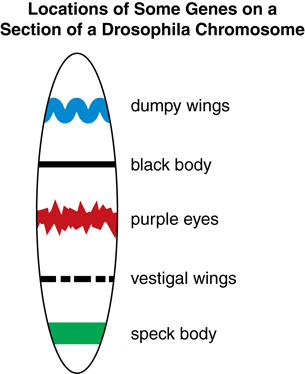
SC 4. To determine whether this is an X chromosome or an autosome, a researcher would have to determine whether these traits are
- recessive
- dominant
- passed from male parents to their male offspring
- passed from female parents to their male offspring
Use the following information to answer SC 5.
Scientists have identified a genetic condition that apparently makes some men prone to impulsive, violent behaviour. A pedigree was drawn highlighting the violent members of a particular family. It appeared, from the pedigree, that men who displayed this violent behaviour inherited this condition from their mothers, not their fathers. Further evidence showed that this was the mode of inheritance.
SC 5. The inheritance pattern described indicates that this condition is
- X-linked
- Y-linked
- autosomal
- codominant
 Self-Check Answers
Self-Check Answers
SC 1. C
SC 2. 0.25 or ![]()
SC 3. D
SC 4. D
SC 5. A
 Reflect on the Big Picture
Reflect on the Big Picture

© Felix Mizioznikov /shutterstock
Would you be worried if all the men in your family were balding? That was a question in the Big Picture. You might be very concerned if you are a male, but not if you are a female.
You know that genes occur on chromosomes, and that males have only one X chromosome, while females have two. This knowledge helps you explain why some traits occur more frequently in males than in females. Males just can’t cover up what’s been given to them by their mothers. Remember that the Y chromosome is virtually “blank.” Any allele on the X chromosome received from the mother will express itself. For females to express an X-linked trait, they must be homozygous recessive. By Mendelian ratios, they have a one in four chance of that happening.
Before beginning your Lesson 6 Assignment, you may wish to do the “Section 17.1 Review” questions on page 598. Your teacher can recommend which questions would be best for you. Discuss your responses with your teacher.
 Module 6: Lesson 6 Assignment
Module 6: Lesson 6 Assignment
Submit your completed Module 6: Lesson 6 Assignment to your teacher for assessment.
1.31. Page 4
Module 6—Mendelian Genetics: The Transmission of Traits to the Next Generation
 Lesson Summary
Lesson Summary
During this lesson you were to examine the following focusing questions:
- Why do some traits appear more frequently in one gender than the other?
- How did Thomas Hunt Morgan’s work create experimental support for the chromosomal theory of inheritance?
Genes occur on chromosomes. This is true for all chromosomes, including the X chromosome. However, the Y chromosome has few genes. Since males receive only one X chromosome, they will have a different rate of inheritance than females for all traits whose alleles are located on the X chromosome. Most genetic diseases are recessive traits. So, for any recessive traits or diseases appearing on the X chromosome, males will have a higher incidence of that trait or disease than will females. Males will always express whichever allele they receive on the X chromosome. Therefore, males have a 50 : 50 chance of expressing the trait. Females often have at least one normal, dominant allele to “cover up” the disease, as in the homozygous dominant and in the heterozygous condition. To express the recessive X-linked trait, a female must be homozygous recessive.
Thomas Hunt Morgan and his team worked with fruit flies to try to disprove the chromosomal theory of inheritance. However, Morgan's work proved to generate experimental evidence that actually supported the theory. This evidence indicated that genes were in fact located on chromosomes. For this work he received the Nobel Prize in 1933.
Lesson Glossary
Consult the glossary in the textbook for other definitions that you may need to complete your work.
chromosomal theory of inheritance: the theory that chromosomes are strings of genes and that each gene has a specific location on a specific chromosome
hemophilia: an X-linked recessive condition; caused by the recessive allele of the Factor VIII gene on the X chromosome; characterized by inability to clot blood
progeny: offspring
sex-linked: a trait that is found in one gender more than another; contrary to autosomal traits that are found equally in both genders
X-linked: a trait that is found in one gender more than in the other gender, and so is sex-linked; contrairy to autosomal traits, which are found equally in both genders
1.32. Lesson 7
Module 6—Mendelian Genetics: The Transmission of Traits to the Next Generation
Lesson 7—Genes and the Environment

© Nagy Melinda/shutterstock
 Get Focused
Get Focused
Nature verses nurture. Have you heard the ongoing debate over which is the strongest influence on a person’s life? While this debate is more focused on innate qualities versus personal experiences, it has relevance in genetics too. Our environment can significantly influence our genes. Sun exposure triggers all kinds of genes to be expressed in plants and animals. Exposure to or lack of water can change the development of leaves in the same plants, particularly their expression of colour intensity. Changes in temperature cause the expression of dark pigment in some rabbits and in Siamese cats. These are very specific examples, but just how much the environment affects gene expression is open for discussion. In this lesson, you will explore the effect the environment may have on the expression of genes.
In this lesson, the following focusing question will be examined:
- How does the environment affect the expression of genes?
nature: in reference to the nature versus nurture debate, refers to the components of an individual’s phenotypes that are determined by his or her genes (e.g., approximately 50% of intelligence is thought to be due to nature)
nurture: refers to the component of one’s phenotypes that are determined by one’s environment
innate: a characteristic one is born with
environment: all non-genetic factors that affect a person’s characteristics (e.g., how he or she was raised, light levels, friends, temperature, good and bad experiences, diet and nutrients available, and so on)
expression: refers to the transcription and translation of the gene to produce the requested protein
Whether or not an allele will be expressed is affected by whether or not the allele is dominant; whether the product is needed by the cell; the stage of the life cycle; and, to some degree, the environmental conditions. In undifferentiated cells, all genes are expressed; in differentiated cells only some genes are expressed.
 Module 6: Lesson 7 Assignment
Module 6: Lesson 7 Assignment
Your teacher-marked Module 6: Lesson 7 Assignment requires you to submit a response to the following:
- a lab on temperature and gender
The lab presents questions on nature versus nurture for assessment.
Download a copy of the Module 6: Lesson 7 Assignment to your computer now. You will receive further instructions on how to complete this assignment later in the lesson.
Continue to add to your flash cards.
You must decide what to do with the questions that are not marked by the teacher.
Remember that these questions provide you with the practice and feedback that you need to successfully complete this course. You should record the answers to all of the questions and place those answers in your course folder.
Remember you also have the option of trying additional questions from the textbook for further practice. Consult with your teacher for the answers to these questions. The Key will also provide you with many Diploma Exam-style multiple-choice, numerical-response, and written-response questions that will be an excellent review of the module. Practising your responses to these types of questions is good preparation for the Diploma Exam.
1.33. Page 2
Module 6—Mendelian Genetics: The Transmission of Traits to the Next Generation
 Explore
Explore
 Read
Read
Read the section in your textbook on “Genes and the Environment” on page 609.
 Watch and Listen
Watch and Listen
You may choose to watch all of the video “Alternate Patterns of Inheritance: the Potential for Diversity” because of its relevance to the course. However, at this time, you may wish to just concentrate on the following short segments. Remember that you can ask your teacher for a username and password to access the video.
- “Bio Break: Environmental Influences”
- “Bio Discovery: Environmental Influence”
 Try This
Try This
Answer the following questions and save your work in your course folder.
TR 1. Is height in humans determined only by our genes?
TR 2. Are our interests genetic or environmental?
TR 3. How does temperature affect coat colour in rabbits?
 Module 6: Lesson 7 Assignment—Labs
Module 6: Lesson 7 Assignment—Labs
Can eating sweets or salty foods determine if a pregnant couple will have a boy or a girl? Despite some persistent folk tales, there is nothing a person can do while pregnant that will influence the gender of their child. However, this is not the case with other species. In this exploration, you will determine if a change in temperature will have an effect on the gender of hatching chickens or geckos. You will see how environment can affect the expression of genes already present in the developing embryos.
Complete this gizmo on the effect of temperature on gender and all related activities. You will be prompted to complete your Module 6: Lesson 7 Assignment as part of the lab.
1.34. Page 3
Module 6—Mendelian Genetics: The Transmission of Traits to the Next Generation
 Reflect and Connect
Reflect and Connect
The incredible effect of temperature on the gender of gecko hatchlings is experimental evidence that genes are affected by the environment. As you answer the following questions, reflect on the effect of the environment on genes and connect your understanding to developing your solutions.
 Self-Check
Self-Check
Use the following information to answer SC 1.
Sickle cell anemia is an autosomal recessive genetic disorder. Because individuals affected by sickle cell anemia have defective hemoglobin proteins, their blood cannot transport oxygen properly. There appears to be a relationship between the incidence of malaria and sickle cell anemia. Individuals with sickle cell anemia and carriers of the sickle cell allele have some resistance to malaria. Malaria is caused by the parasite Plasmodium and is transmitted between humans by mosquitoes.
autosomal recessive: a condition caused by a gene found on an autosome (non-sex chromosome), which only occurs in those with the homozygous recessive genotype
malaria: a disease of warm, wet areas caused by the plasmodiumprotist found in the Anopheles mosquito
When the mosquito bites a person, the plasmodium enters the blood stream and lays its eggs in red blood cells. Sickled red blood cells typical of those people with sickle cell anemia (SCA) are harder for the plasmodium to attack, so those with SCA are less likely to die of malaria. The homozygous recessive condition (ss) confers a disadvantage (SCA) and an advantage (protection from malaria).
SC 1. If scientists are successful in significantly reducing or eliminating malaria, the best prediction for what will happen to the allele for sickle cell anemia in the population is that it will
- not be affected by the elimination of malaria
- increase as its selective advantage is increased
- be reduced as its selective advantage is decreased
- quickly disappear as its selective advantage is increased
Use the following information to answer SC 2.
Melanin pigments range in colour from yellow to reddish-brown to black. The amount and the colour of melanin in the skin account for differences in human skin coloration.
Albinism is a genetic disorder that results in unpigmented skin and other tissues. About 1 in 20 000 humans has albinism. In humans, albinism can be caused by an autosomal recessive allele (a). Its dominant allele (A) results in normal pigmentation.
SC 2. The fact that exposure to sunlight increases melanin production in many humans and produces a tan demonstrates that
- some people have mutations that prevent melanin production
- the expression of some genes is influenced by the environment
- the environment causes mutations that increase the chance of survival
- the environment causes mutations that have no effect on the chance of survival
Use the following information to answer SC 3.
Sickle cell anemia is caused by the sickle cell allele (HbS) of a gene that contributes to hemoglobin (Hb) production. The abnormal hemoglobin (hemoglobin-S) produced causes red blood cells to become deformed and block capillaries, and there is resultant tissue damage. Affected individuals homozygous for the sickle cell gene rarely survive to reproductive age. Heterozygous individuals produce both normal hemoglobin and a small percentage of hemoglobin-S. These individuals are more resistant to malaria than individuals who are homozygous for the allele for normal hemoglobin (HbA). Their red blood cells are prone to sickling when there is a deficiency of oxygen.
SC 3. Which of the following conclusions can be drawn from all of the information provided on sickle cell anemia?
- The sickle cell gene will eventually disappear because of its interaction with malaria.
- Malaria causes heterozygous individuals to be less fertile than homozygous individuals.
- In Africa, sickle cell anemia will disappear since it is lethal in the homozygous condition.
- In Africa, carriers for sickle cell anemia have an advantage over homozygous individuals.
 Self-Check Answers
Self-Check Answers
SC 1. C
SC 2. B
SC 3. D
 Discuss
Discuss

© Photoroller/shutterstock
Consider the nature verses nurture debate. When you consider who you are, from your personality to the unique shape of your nose, what do you think has had the greatest influence in the making of who you are? Was it the random assortment of genes that you received at fertilization of your father’s and mother’s gametes? Has it been your environment and your upbringing that have allowed you to be taller, smarter, or funnier than those around you? Considering the variety of traits, such as height and behaviour, which do you believe is the definitive influence: genetics or environment?
Research this issue. Write a summary of your position and discuss your position with your peers and teacher in the class discussion area. Engage your peers in the defense of your position, and challenge others on their positions.
Discussion Rubric
Learning Outcome |
Exemplary (all points) 3 marks |
Accomplished (most of the points) 2 marks |
Developing (minimal points) 1 mark |
Not yet started 0 marks |
Communicates Ideas |
The learner communicates ideas eloquently and thoroughly. |
The learner communicates ideas, opinions, and conclusions clearly and completely. |
The learner communicates ideas well, but fails to provide evidence to support his or her ideas, opinions, and conclusions. |
The learner fails to communicate his or her ideas. |
Understanding of the Activity |
The learner’s contribution to the discussion board demonstrates a thorough understanding of the concept being presented, be it stem cell research, reproductive technology, drug use, or the environment. |
The learner’s contribution to the discussion board demonstrates an understanding of the concept being presented. |
The learner’s contribution to the discussion board demonstrates a developing understanding, but further explanation and exploration is needed. |
The learner’s contribution does not demonstrate an understanding of the task |
Peer Review |
The learner provides meaningful feedback on others’ ideas. |
The learner provides meaningful feedback on others’ ideas. |
The learner provides comments on others’ ideas, but not specific feedback. The learner’s response discourages other group members to share ideas. |
The learner does not comment on other posts. |
Mechanics of Messages |
The learner’s response has an obvious logical and/or sequential organization. |
The learner’s response has an obvious logical and/or sequential organization. |
The learner’s response lacks organization. |
The learner’s response cannot be followed or understood. |
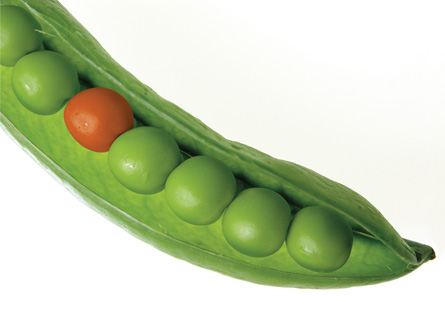
© Steven Coling/shutterstock
 Reflect on the Big Picture
Reflect on the Big Picture
Throughout this module, you have discovered many reasons for the variation that you see in organisms. You have come to understand how members of your family can either look alike or be very different in appearance. Gene expression is also affected by the environment.
Inheritance patterns can be clearly followed and predicted up until the influence of the environment takes effect. The effect of the environment on our genes adds a level of complexity to the understanding of inheritance. Many genes might be present in individuals, but without the proper environmental exposure, they may never be expressed. As a result, the inheritance of traits may always happen according to the principles you’ve learned, but the expression of those traits may not always occur as predicted. Even with current knowledge of genetics, life can be surprising, as you discovered in the lab.
 Module 6: Lesson 7 Assignment
Module 6: Lesson 7 Assignment
Submit your completed Module 6: Lesson 7 Assignment to your teacher for assessment.
1.35. Page 5
Module 6—Mendelian Genetics: The Transmission of Traits to the Next Generation
 Lesson Summary
Lesson Summary
During this lesson, you explored the following focusing question:
- How does the environment affect the expression of genes?
Through your research for the discussion post, and from your exploration of temperature and gecko hatchings, you should see that there can be a strong and dynamic influence by the environment on gene expression. This influence accounts for some of the variance in traits, such as height. Whether this environmental effect on the expression of genes is stronger than the very inheritance of those genes is still up for debate.
Lesson Glossary
Consult the glossary in the textbook for other definitions that you may need to complete your work.
autosomal recessive: a condition caused by a gene found on an autosome (non-sex chromosome), which only occurs in those with the homozygous recessive genotype
environment: all non-genetic factors that affect a person’s characteristics (e.g., how he or she was raised, light levels, friends, temperature, good and bad experiences, diet and nutrients available, and so on)
expression: refers to the transcription and translation of the gene to produce the requested protein
Whether or not an allele will be expressed is affected by whether or not the allele is dominant; whether the product is needed by the cell; the stage of the life cycle; and, to some degree, the environmental conditions. In undifferentiated cells, all genes are expressed; in differentiated cells only some genes are expressed.
innate: a characteristic one is born with
malaria: a disease of warm, wet areas caused by the plasmodiumprotist found in the Anopheles mosquito
When the mosquito bites a person, the plasmodium enters the blood stream and lays its eggs in red blood cells. Sickled red blood cells typical of those people with sickle cell anemia (SCA) are harder for the plasmodium to attack, so those with SCA are less likely to die of malaria. The homozygous recessive condition (ss) confers a disadvantage (SCA) and an advantage (protection from malaria).
nature: in reference to the nature versus nurture debate, refers to the components of an individual’s phenotypes that are determined by his or her genes (e.g., approximately 50% of intelligence is thought to be due to nature)
nurture: refers to the component of one’s phenotypes that are determined by one’s environment
1.36. Lesson 8
Module 6—Mendelian Genetics: The Transmission of Traits to the Next Generation
Lesson 8—Polygenetic Traits
 Get Focused
Get Focused
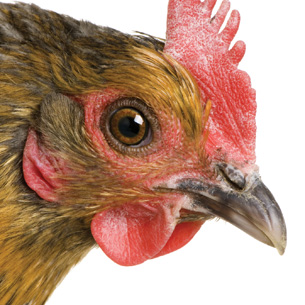
© Eric Isselée/shutterstock
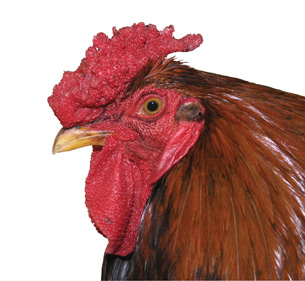
© Margo Harrison/shutterstock
The top of a chicken’s head has a fleshy growth known as a comb. There are four possible phenotypes for chicken combs: rose, pea, walnut, and single. You might suspect multiple alleles were responsible for this trait. However, a walnut chicken can be crossed with another walnut chicken and their offspring can display all four of the possible phenotypes. These results would not be possible with any amount of alleles if this trait were controlled by a single gene. This type of inheritance is only possible if more than one gene is acting to affect the same trait.
In this lesson, you will study traits that are controlled by many genes. You will recognize inheritance patterns that show gradual changes in phenotypes, and you will understand that the expression of one gene can turn the expression of another gene on or off.
In this lesson, the following focusing question will be examined:
- How might multiple genes combine to form a single trait?
 Module 6: Lesson 8 Assignment
Module 6: Lesson 8 Assignment
Your teacher-marked Module 6: Lesson 8 Assignment requires you to submit a response to questions on breeding taller corn.
Download a copy of the Module 6: Lesson 8 Assignment to your computer now. You will receive further instructions on how to complete this assignment later in the lesson.
Continue to add vocabulary, with supporting examples where necessary, to your flash cards.
You must decide what to do with the questions that are not marked by the teacher.
Remember that these questions provide you with the practice and feedback that you need to successfully complete this course. You should record the answers to all of the questions and place those answers in your course folder.
You also have the option of trying additional questions from the textbook for further practice. Consult with your teacher for the answers to these questions. The Key will also provide you with many Diploma Exam-style multiple-choice, numerical-response, and written-response questions that will be an excellent review of the module. Practising your responses to these types of questions is good preparation for the Diploma Exam.
1.37. Page 2
Module 6—Mendelian Genetics: The Transmission of Traits to the Next Generation
 Explore
Explore
 Read
Read
continuous traits: traits that have a range of phenotypes, such as human height or eye colour with its many shades; is due to the polygenic effect of many genes together
polygenic inheritance: where more than one gene (often several) are involved in determining the phenotype for one characteristic (e.g., eye colour is actually the result of multiple genes that collectively contribute to the final eye colour)
epistasis: a type of polygenic inheritance where two genes collectively determine a phenotype of a trait (e.g., the B gene codes for type of colour (B = black, b = brown) and the C gene determines whether colour occurs at all (C = colour, c = no colour); three phenotypes result—white, brown, and black)
Many traits are actually regulated by more than one gene. The result is a range of phenotypes, from one extreme to the other. The range in phenotypes is termed continuous traits. Eye colour in Drosophila; milk production in cows; and skin colour, eye colour, and height in humans are a few examples of traits determined by more than one gene. Traits that are determined by the interaction of two or more genes are termed polygenic traits. Although the phenotype expression of these traits can be influenced by the environment, as you learned in the last lesson, these traits also have many genes interacting to form the final phenotype.
This lesson will focus on traits that result from the interaction of only two genes. Traits can be affected by many more than two genes, but this becomes very complicated. Traits affected by multiple genes produce much more variability than a trait affected by one gene. Polygenic genes can involve incomplete dominance, involve multiple alleles, and be affected by the environment.
Another source of variation is epistasis. In epistasis, one set of genes will interfere with or affect the expression of another set of genes. The following example of coat colour in mice involves a gene set, B and b, producing colour, while another gene set, C and c, affects pigment production. You will discover how Bbcc phenotype is black, but BbCc phenotype results in no colour, or a white coat.
Study the following examples of polygenic traits.
Example 1
In the example of chicken combs in the Get Focused section, two genes combine to form a phenotype that neither gene is capable of producing by itself. This is a continuous trait. One of the genes, the rose gene, has two alleles; an R for a rose comb that is dominant over an r allele that leads to a single comb. The other gene, the pea gene, also has two alleles; a P for a pea comb that is dominant over a p allele that will lead to a single comb. Remembering that a chicken will have both of these genes at the same time, here are the possible genotypes for the given phenotypes so far:
- Rose comb: Rrpp or RRpp
- Pea comb: rrPp or rrPP
- Single comb: rrpp
The forth phenotype is the walnut comb. A walnut comb results from the presence of at least one dominant allele in the two different genes. The possible genotypes for this are as follows:
- Walnut comb: RRPP, RrPP, RRPp, or RrPp
When analyzing polygenic traits, the movement of alleles follows the same patterns as in dihybrid crosses, however, the resulting genotypes must be interpreted for only one trait instead of two. For example, if a true breeding rose chicken (RRpp) were crossed with a true breeding pea chicken (rrPP), the F1 would be all walnut (RrPp). Continuing on to the F2, there would be a 9 walnut : 3 rose : 3 pea : 1 single comb phenotypic ratio. This looks just like Mendel’s work, until you remember that those ratios are for four different phenotypes of one trait only.
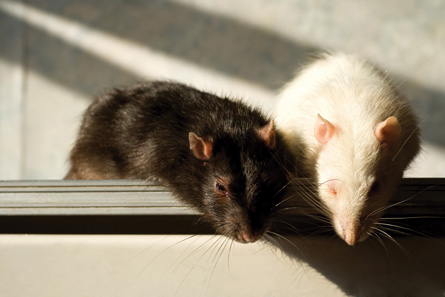
© Alexander Lukin/shutterstock
Example 2
Epistasis involves gene interaction where one gene masks the expression of another. A common example is coat colour in mice. Here, one gene determines if pigment is created at all, while another gene determines the type of pigment, like black or brown. In this example, the gene that controls the creation of pigment has two alleles. The allele to produce pigment C is dominant over the allele that will lead to no pigment or white, c. The other gene that controls the colour of the pigment also has two alleles. B is dominant and produces a black pigment, while b is recessive and will lead to brown pigment. Here are the possible phenotypes and their genotypes for this trait.
- Black: BBCC, BbCC, BBCc, BbCc
- Brown: bbCC, bbCc
- White: BBcc, Bbcc, bbcc
When trying to determine phenotype in epistasis, it is often helpful to consider a flow chart:

For an example cross, start with a black mouse (BBCC) and a white mouse (bbcc). The F1 will all be black (BbCc). Continuing on to the F2, there will be 9 black : 3 brown : 4 white mice. This is an unusual ratio and not the typical 9 : 3 : 3 : 1 ratio you might have been expecting. Unusual ratios are a characteristic of epistasis.
Polygenic traits can involve the interaction of more than just two genes. These would be too complex for you to predict and analyze; but, in a general sense, they are not too difficult to understand. Basically, the more genes there are involved in creating a single trait, the greater the variety of possible phenotypes. Read about polygenic traits and continuous phenotypes in your textbook on pages 605 to 607, “Polygenic Inheritance.”
 Watch and Listen
Watch and Listen
Note the questions in the following Try This activity. Then return to the video “Alternate Patterns of Inheritance: the Potential for Diversity” and watch the following sections. Remember that you can ask your teacher for a username and password to access the video.
- “Bio Quest: Rabbit Breeding”
- “Bio Discovery: Other Inheritance Patterns”
- “Bio Review: Patterns of Inheritance”
Try This
To ensure your understanding of the concepts of polygenic inheritance, answer the following questions. Ask your teacher for assistance if necessary, and file the results in your course folder.
TR 1. How many phenotypes are there for rabbit fur colouration?
TR 2. How many genes are involved in determining rabbit fur colours?
TR 3. How many genes are involved in determining human skin colour? What else affects human skin colour?
TR 4. What is the phenotypic ratio of purple to white flowers in the case of epistasis?
pleiotropy: the reverse of polygenic inheritance; where one gene affects the phenotypes for several traits (e.g., the PKU gene affects mental retardation, skin colour, hair colour, and other traits)
TR 5. Define or explain the following patterns of inheritance.
- incomplete dominance
- multiple alleles
- pleiotropy
- epistasis
- co-dominance
- polygenic inheritance
- the effect of the environment (is this really a pattern of inheritance?)
 Self-Check
Self-Check
Use the following questions to confirm your understanding of polygenetic inheritance.
SC 1. In chickens, most birds do not have feathers on their legs. This phenotype is the result of two genes interacting and having only recessive alleles for both genes. The presence of a dominant allele for either gene or for both genes causes feathers. What is the feathered leg : unfeathered leg ratio in the offspring of chickens that are heterozygous for both genes?
- 9 : 7
- 12 : 4
- 13 : 3
- 15 : 1
SC 2. In corn plants, a dominant allele (I) inhibits kernel colour, while the recessive allele (i) permits colour when homozygous. At a different locus, the dominant gene P causes purple kernel colour, while the homozygous recessive genotype pp causes red kernels. If plants that are heterozygous at both loci are crossed, what will be the phenotypic ratio of the F1 generation?
 Self-Check Answers
Self-Check Answers
SC 1. D 15 : 1 since all 15 have at least one dominant allele, and only 1 in 16 will have pure recessive alleles.
SC 2. Corn plants and kernel colour.
I = inhibits colour, thus II or Ii will give no colour
ii = gives colour
P = purple if colour present, so PP or Pp will give purple
pp = red if colour present
Parents: IiPp x IiPp
Gametes: [IP], [Ip], [iP], [ip] x [IP], [Ip], [iP], [ip]
Offspring: 9 I_P_ : 3 iiP_ : 3 I_pp : 1 iipp
Since I_ will give no colour at all, from the analysis of the above ratio of alleles, you get 12 no colour : 3 Purple : 1 red. That’s a 12 : 3 : 1 ratio.
1.38. Page 3
Module 6—Mendelian Genetics: The Transmission of Traits to the Next Generation
 Reflect and Connect
Reflect and Connect
Polygenic and epistatic traits help you understand the variation that can exist in individuals. The wide range of eye colour, hair colour, and skin colour in humans can be explained as polygenic traits.
When a walnut chicken was crossed with another walnut chicken, all four of the possible phenotypes for the comb found in chickens were produced. From your work with Mendelian genetics, you realize that these results would not be possible with any amount of alleles if this trait were controlled by a single gene. This type of inheritance is only possible if more than one gene is acting to affect the same trait. This is termed a polygenic trait.
The coat colour in many animals is explained through epistatic genes. If you have a cat, you may now be able to understand the variation that can occur in the phenotypes of a new litter of kittens.
Add any new terms to your flash cards. Review all the flash cards you have created to date and test yourself to ensure that you are mastering the concepts and vocabulary.
Before you begin the lesson assignment, to consolidate the concepts that you have learned about the principles of inheritance of traits and the tools used to study these principles, you might choose to do a selection of questions from pages 598, 606, and 609. Consult with your teacher as to which questions would best suit your review. You teacher will provide feedback to your responses.
OR
Apply your understanding of this lesson by completing the following Self-Check questions.
 Self-Check
Self-Check
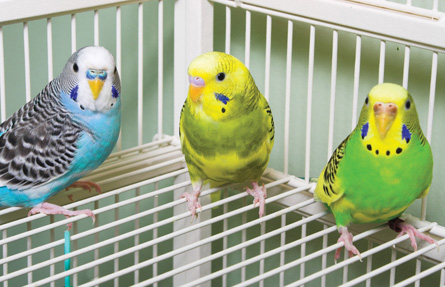
© Rob Byron/shutterstock
Feather colour in parakeets is controlled by two genes. For one pigment gene, the B allele produces blue colour, and the b allele does not produce any colour at all. For the other pigment gene, the Y allele produces yellow colour, and the y allele does not produce any colour at all. Any genotype containing at least one B allele and one Y allele will produce a green parakeet.
SC 3. Which of the following parental genotypes could produce offspring displaying all four different colour patterns?
- BBYy BbYy
- BbYY Bbyy
- bbYY bbyy
- Bbyy bbYy
SC 4. What is the probability of obtaining a blue parakeet when two green heterozygous parakeets are crossed?
- 0
- 3/16
- 1/4
- 9/16
Use the following information to answer the next questions.
Two different genes control the expression of kernel colour in Mexican black corn: a black pigment gene (B), and dotted pigment gene (D). Gene B influences the expression of gene D. The dotted phenotype appears only when gene B is in the homozygous recessive state. A colourless variation occurs when both genes are homozygous recessive.
After pure-breeding black-pigmented plants were crossed with colourless plants, all of the offspring were black-pigmented.
—from Grifiths et al., 1993
SC 5. The genotypes of the parents of these F1 offspring could be
- BBDD bbdd
- BbDD bbdd
- Bbdd bbDD
- bbDD BBdd
SC 6. Plants of the F1 generation are suspected of being heterozygous for both genes. A test cross of colourless plants with the heterozygote plants should produce a phenotypic ratio in the offspring of
- 1 : 0
- 3 : 1
- 2 : 1 : 1
- 1 : 1 : 1 : 1
Numerical Response
Use the following information to answer SC 7.
In Labrador retriever dogs, two alleles (B and b) determine whether coat colour will be black (B) or brown (b). Black coat colour is dominant. A second pair of alleles, E and e, are on a separate chromosome from B and b. The homozygous recessive condition, ee, prevents the expression of either allele B or b, and produces a dog with a yellow-coloured coat. Some examples of genotypes and phenotypes for Labrador retrievers are shown below.
Genotype Phenotype
BBEe black
bbEe brown
Bbee yellow
SC 7. Two dogs, each with the genotype BbEe, were crossed. What is the percentage probability that their offspring would have yellow coat colour? (Record your answer as a whole number percentage).
 Reflect and Connect Answers
Reflect and Connect Answers
SC 3. D
SC 4. B
SC 5. A
SC 6. C
SC 7. 25%
 Module 6: Lesson 8 Assignment
Module 6: Lesson 8 Assignment
In this assignment you will work with the breeding of corn. You will be trying to produce taller corn plants, which are an important food and fuel crop.
Retrieve your copy of the Module 6: Lesson 8 Assignment that you saved to your computer earlier in this lesson. Complete the assignment. Save your completed assignment in your course folder. You will receive instructions later in this lesson on when to submit your assignment to your teacher.
 Reflect on the Big Picture
Reflect on the Big Picture
In the Big Picture you wondered about all the variation in your family. Many of their characteristics, including skin colour, have a continuous phenotype. There can even be individuals with characteristics that don’t seem to be in any other family members. These characteristics are probably the result of polygenetic inheritance.
Polygenic inheritance is another example of an inheritance pattern that leads to a wide phenotypic variety in offspring. From your study of polygenic traits in this lesson, you should be able to understand how the expression of genes for traits such as human hair colour and eye colour can be influenced by many genes.
 Going Beyond
Going Beyond
Completing this question will build on your understanding on gene interaction.
In humans, there is a dominant allele that causes vitiligo, where small-unpigmented spots appear on the body. Also, there is a recessive allele for another gene that causes albinism, which causes the entire body to be unpigmented. Since there is no pigment in albinos, Vitiligo cannot be seen in albinos.
A man with vitiligo had an albino mother and a father with neither vitiligo nor albinism. If the man has a child by a phenotypically normal-skinned woman who had an albino father, what is the probability of having a phenotypically normal child?
- 0
- 1/8
- 3/8
- 5/8
 Module 6: Lesson 8 Assignment
Module 6: Lesson 8 Assignment
Submit your completed Module 6: Lesson 8 Assignment to your teacher for assessment.
1.39. Page 4
Module 6—Mendelian Genetics: The Transmission of Traits to the Next Generation
 Lesson Summary
Lesson Summary
During this lesson you were to examine the following focusing question:
- How might multiple genes combine to form a single trait?
Multiple genes can contribute to the expression of only one trait. Two genes may combine to form a new phenotype that neither can produce on their own. One gene may also affect or control the expression of another gene by regulating a factor that is required by the other gene, such as pigment for hair cells. Many continuous phenotypes, such as corn length or bean mass, can be explained by each dominant allele of a gene collection being a greater contributor to the total. In each of these examples, more than one gene is combining to give rise to a single trait that can be observed.
Lesson Glossary
Consult the glossary in the textbook for other definitions that you may need to complete your work.
continuous traits: traits that have a range of phenotypes, such as human height or eye colour with its many shades; is due to the polygenic effect of many genes together
epistasis: a type of polygenic inheritance where two genes collectively determine a phenotype of a trait (e.g., the B gene codes for type of colour (B = black, b = brown) and the C gene determines whether colour occurs at all (C = colour, c = no colour); three phenotypes result—white, brown, and black)
pleiotropy: the reverse of polygenic inheritance; where one gene affects the phenotypes for several traits (e.g., the PKU gene affects mental retardation, skin colour, hair colour, and other traits)
polygenic inheritance: where more than one gene (often several) are involved in determining the phenotype for one characteristic (e.g., eye colour is actually the result of multiple genes that collectively contribute to the final eye colour)
1.40. Lesson 9
Module 6—Mendelian Genetics: The Transmission of Traits to the Next Generation
Lesson 9—Crossing Over Frequencies and Gene Mapping
 Get Focused
Get Focused

© Le Loft 1911/shutterstock
Sometimes you can find what you are looking for by finding something else that should be in a similar location. Early stud finders worked this way. About 20 years ago, if you wanted to find a 2 × 4 stud in your wall, you may have used a floating magnet held close to the wall. The magnet would move directly over the stud because it was attracted to the nails in the stud.
After discovering that genes occurred on chromosomes, scientists learned how to map the relative distances between these genes. This can be tremendously helpful for locating “genes of interest,” such as genes that cause disease. When scientists already knew the location of more common genes on the same chromosome, then they were able to find the “genes of interest” quickly and easily. This is like finding the nail so that you could find the stud.
In this lesson, you will learn how genes that are found on the same chromosome tend to move together and are said to be linked. Using your understanding of crossing-over from meiosis, you will learn how this allows scientists to map the relative locations of genes on the same chromosome.
In this lesson, the following focusing questions will be examined:
- How does crossing-over in chromosomes relate to finding the locations of genes on chromosomes?
- What is the importance of knowing where genes are located on a chromosome?
 Module 6: Lesson 9 Assignment
Module 6: Lesson 9 Assignment
Your teacher-marked Module 6: Lesson 9 Assignment requires you to submit the following:
- a lab on mapping chromosomes
- participation in a discussion on the importance of gene mapping
Download a copy of the Module 6: Lesson 9 Assignment to your computer now. You will receive further instructions on how to complete this assignment later in the lesson.
Add terms from this lesson to your flash cards.
You must decide what to do with the questions that are not marked by the teacher.
Remember that these questions provide you with the practice and feedback that you need to successfully complete this course. You should record the answers to all of the questions and place those answers in your course folder.
You also have the option of trying additional questions from the textbook for further practice. Consult with your teacher for the answers to these questions. The Key will also provide you with many Diploma Exam-style multiple-choice, numerical-response, and written-response questions that will be an excellent review of the module. Practising your responses to these types of questions is good preparation for the Diploma Exam.
1.41. Page 2
Module 6—Mendelian Genetics: The Transmission of Traits to the Next Generation
 Explore
Explore
 Read
Read
Recall from Lesson 6 on sex–linked inheritance that Thomas Hunt Morgan provided experimental evidence that genes occur on chromosomes. This discovery immediately created a new idea from Mendel’s laws: the idea that traits could tend to move together if they were on the same chromosome.
Mendel did not find that any of the seven traits he studied moved together. Each trait had no relation to another: each trait assorted independently. The traits that Mendel studied in peas were found on different chromosomes, so we would expect them to move independently.

However, many traits in organisms are coded on the same chromosome. These genes tend to move together, and are thus called linked genes. When first considering linked genes, you may think that these genes always move together; however, that is not the case. Even though they are on the same chromosome, there is an opportunity to exchange pieces of homologous chromosomes during meiosis. This process is called crossing over.
The farther apart two genes are on a chromosome, the greater the number of crossover events that will occur between them, and it is less likely that the two traits will move together. The number of crossover events directly relates to distance on a chromosome. Read “Crossing Over and Inheritance” to the end of “Chromosome Mapping” on pages 599 to 601 of your textbook.
 Watch and Listen
Watch and Listen
Watch the following segments of the video “Chromosomal Basis of Inheritance: The Choreography of Generations.” Remember that you can ask your teacher for a username and password to access the video.
- “Bio Reports: Inheritance”
- “Dyhybrid Crosses”
- “Bio Bit: Genetic Diversity”
- “Bio Discovery: Gene Linkage”
- “Gene Linkage”
- “Bio Discovery: Crossing Over”
- “Bio Probe: Gene Mapping”
- “Bio Bit: Chromosome and Gene Mapping”
- “Bio Bit: Barbara McClintock”
Remember to add the new terms to your flash cards.
 Try This
Try This
Apply your understanding to the following questions and save your work in your course folder.
parental type: in a linkage cross, if the offspring look like either parent, then they are parental types (e.g., if we assume A and B are linked together and a and b are linked together in the linkage cross AaBb X aabb, any offspring that are AaBb or aabb are parental types)
non-parental type: in a linkage cross, any offspring of the above cross that don’t look like the parents (Aabb or aaBb) are non-parental types, are the results of crossing over, and are recombinants
TR 1. How would the phenotypic ratio of the cross GgRr × ggrr be different for independent assortment than for linked genes?
TR 2. What is meant by parental types of chromosomes?
TR 3. What is meant by non-parental types of chromosomes?
TR 4. How does recombination frequency relate to map distance?
recombination frequency: the number of recombinant offspring divided by the total number of offspring X 100; expressed as a percentage; used as a map distance between the two genes (e.g., the recombination frequency was 32%, therefore the two genes are 32 map units apart on the chromosome)
map distance: how far apart (in centimorgans) two genes are on a chromosome; the recombination frequency from a linkage cross is used as the map distance between two genes (e.g., 44% of the offspring of the linkage cross were recombinants, therefore the two genes are 44 map units or 44 cM apart)
 Module 6: Lesson 9—Lab: Mapping Chromosomes
Module 6: Lesson 9—Lab: Mapping Chromosomes
In this lab you will practise creating your own map by completing Part A of “Thought Lab 17.1: Mapping Chromosomes” on page 602 of your textbook. This work will become part of your assignment for assessment in this lesson.
Retrieve your copy of Module 6: Lesson 9 Assignment that you saved to your computer earlier in this lesson. Complete Part A of the “Thought Lab”. Save your work in your course folder. You will receive instructions later in this lesson on when to complete your assignment and submit it to your teacher.
Then complete Part B of “Thought Lab 17.1: Mapping Chromosomes” on page 602. Discuss your work in Part B with your teacher and save your responses to your course folder.
 Self-Check
Self-Check
Determining recombinant types in crosses and calculating recombination frequency is challenging. However, maps can be easily created from those frequencies. To help you practice the principles of gene mapping, answer the following questions.
SC 1. If there were 50 recombination phenotypes in 250 offspring, what is the map distance between the linked alleles?
recombination: during crossing over in prophase I of meiosis, genes from non-sister chromatids trade places, making new allele combinations in the gametes (e.g., if A is linked to B and a to b, then any gametes that are Ab or aB are the results of recombination or crossingover)
map unit: the unit used is the centimorgan (cM); because the recombination frequency is a percentage, the largest map distance is 100 cM
crossover percentage: same as recombination frequency
SC 2. A three-point test cross is performed to identify the locus of each of three alleles in relation to one another. The results were as follows:
- AB recombinations = 225
- BC recombinations = 165
- AC recombinations = 60
- Parental linkages = 550
- Total offspring = 1000
Show the positions and map the distances apart for each allele (A, B, and C) on a chromosome. Calculate the map units, then draw the chromosome. You will encounter the term crossover percentage in the answer provided.
 Self-Check Answers
Self-Check Answers
SC 1. Crossover % = 50/250 × 100 = 20%
Since 1% crossover represents 1 map unit, 20% crossover would mean 20 map units apart.
SC 2. The crossover percentages and map units are as follows:
- AB = 225/1000 × 100% = 22.5% or 22.5 map units
- BC = 165/1000 × 100% = 16.5% or 16.5 map units
- AC = 60/1000 × 100% = 6.0% or 6.0 map units
Therefore, the mapped chromosome would look like this:
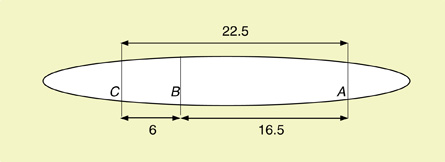
1.42. Page 3
Module 6—Mendelian Genetics: The Transmission of Traits to the Next Generation
 Reflect and Connect
Reflect and Connect
The analysis of linked-gene crosses for recombinant phenotypes and calculation of recombinant frequencies is used to develop gene maps for traits. The hypothesis is that the greater the amount of crossing over between genes, the further apart those genes are on a chromosome. Map units are used to locate genes along the chromosome to form a gene map. Gene maps can provide an understanding of how or why certain traits tend to move together while others may not, even if found on the same chromosome.
To ensure your mastery of linked genes and chromosome mapping, answer the following Self-Check questions.
 Self-Check
Self-Check
Use the following information to answer SC 3 and SC 4.
![The chromosome shows the alleles for several characteristics found in tomatoes. In order, the allelles are leaf texture - normal [M] or mottled [m], plant height - tall [D] or dwarf [d], fruit texture - smooth [P] or peach [p], fruit shape - normal [O] or oblate [o], leaf texture - wooly [Wo] or normal [wo], leaf arrangment on stem - normal[Ne] or necrotic [ne], leaf inflorescence - simple [S] or compound [s], shape of top of fruit - nonbeaked [Bk] or beaked [bk], locules in fruit - few[Lc] or many [lc].](https://moodlehub.ca/pluginfile.php/2977/mod_book/chapter/6163/biology_30/images/m6/b30_m6_039_l.jpg)
SC 3. During meiosis, which of the following pairs of genes has the greatest chance of being separated by crossing over?
- (m) and (d)
- (ne) and (p)
- (m) and (lc)
- (p) and (o)
Use the following additional information to answer SC 4.
Genes |
Crossover Frequency |
normal leaf (M) and tall plant (D) |
12% |
normal leaf (M) and normal tomato (O) |
33% |
normal leaf (M) and simple inflorescence (S) |
64% |
tall plant (D) and normal tomato (O) |
21% |
tall plant (D) and simple inflorescence (S) |
52% |
SC 4. The cross-over frequency between genes O and S is
- 6%
- 29%
- 31%
- 97%
Use the following information to answer SC 5.
Cross-over Frequencies of Some Genes on Human Chromosome 6 |
|
Genes |
Approximate Cross-over Frequencies |
diabetes mellitus (1) and ovarian cancer (2) |
21% |
diabetes mellitus (1) and rhesus blood group (3) |
12% |
ragweed sensitivity (4) and ovarian cancer (2) |
10.5% |
rhesus blood group (3) and ovarian cancer (2) |
9% |
diabetes mellitus (1) and ragweed sensitivity (4) |
31.5% |
Numerical Response
SC 5. On human chromosome 6, the order of the genes numbered above is ___, ___, ___ and ___.
SC 6. What is the approximate crossover frequency between the rhesus blood group gene and the ragweed sensitivity gene?
- 1.5%
- 10.5%
- 19.5%
- 22.5%
Use the following information to answer SC 7.
Gregor Mendel examined the inheritance of two traits in pea plants: seed coat texture and colour. Seed coat texture can be represented as S–smooth and s–wrinkled, and seed coat colour can be represented as Y–yellow and y–green. SSYY plants were crossed with ssyy plants to yield F1 pea seeds that were all smooth and all yellow. By crossing plants grown from these F1 seeds, Mendel obtained four different phenotypes of F2 seeds:
- smooth, green seeds
- wrinkled, green seeds
- smooth, yellow seeds
- wrinkled, yellow seed
SC 7. If the traits for seed coat texture and seed coat colour had been located close together on the same chromosome, Mendel might not have conceptualized
- gene pairs
- dominance
- the law of segregation
- the law of independent assortment
 Reflect and Connect Answers
Reflect and Connect Answers
SC 3. C
SC 4. C
SC 5. 1,3,2,4 or 4,2,3,1
SC 6. C
SC 7. D
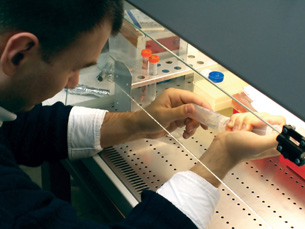
© Cristian Alexandru Ciobanu/shutterstock
The Human Genome Project was one of the largest genetic projects ever completed. It involved the participation of public universities and private companies from around the world, and took over 13 years to complete. Completed, the Human Genome Project represents a relative map of all human genes found on all chromosomes.
However, the project was not without controversy. In order to encourage private companies to take part, these companies were allowed to patent certain tests that can locate specific genes in people, such as genes related to the possibility of developing cancer. As a result, hospitals and labs have to pay these companies for the right to conduct tests to determine if a person is at risk of developing cancer due to family history. In addition, tests for the presence of certain genes may also provide information about other genes that were not originally considered. This kind of information has the potential to be harmful to the individual if it became available to insurance companies, or to a person’s place of employment.
 Discuss
Discuss
Research the issue of private industry in genetic research and/or testing. Take a position on whether or not private industry should be allowed or encouraged to participate in the advancement of the field of personal health. Communicate your position to your peers and instructor on a class discussion board, or in whatever manner your teacher sets up for you. Engage your classmates in the defense of your position, and challenge others to defend their positions. Revise your response after your discussion with your classmates.
 Module 6: Lesson 9 Assignment
Module 6: Lesson 9 Assignment
Retrieve your copy of Module 6: Lesson 9 Assignment that you saved to your computer earlier in this lesson. Paste your revised discussion posting into the D 1 text box. Save your completed assignment in your course folder. You will receive instructions later in this lesson on when to submit your assignment to your teacher.
 Reflect on the Big Picture
Reflect on the Big Picture
Remember wondering in the Big Picture why some family members look alike. If they had dark hair, they also seemed to have curly hair, brown eyes, and a dimpled chin. Using the principles of linkage, you should be able to explain how these characteristics might have been inherited together. Using the principles of crossing over you should also be able to explain why some family members seem to have little resemblance to their parents.
The linkage of genes on chromosomes tends to reduce variability in offspring. Certain genes, and their expression, tend to move together. However, crossing over of chromosomes in meiosis acts as a counter to this trend. Crossing over will increase variability in offspring by creating chromosome combinations not seen in parents.
 Going Beyond
Going Beyond
One of the essential skills in genetics is learning to apply what you know to new situations. For a challenge, do a web search using the terms “biology + Arizona + edu + mendelian genetics + problem sets + sex-linked inheritance.” Work through the second set of sex-linked inheritance problems. In this set, each question builds on the next, and the last question requires an understanding of linked genes.
 Module 6: Lesson 9 Assignment
Module 6: Lesson 9 Assignment
Submit your completed Module 6: Lesson 9 Assignment to your teacher for assessment.
1.43. Page 4
Module 6—Mendelian Genetics: The Transmission of Traits to the Next Generation
 Lesson Summary
Lesson Summary
During this lesson you were to examine the following focusing questions:
- How does crossing-over in chromosomes relate to finding the locations of genes on chromosomes?
- What is the importance of knowing where genes are located on a chromosome?
Genes on the same chromosome tend to be inherited together. When they are not, it can be the result of a crossover event during meiosis. The farther apart the genes are on a chromosome, the more likely a crossover event will occur, and the higher the recombinant frequencies are in the offspring.
By understanding where genes are located on chromosomes, geneticists can better predict the inheritance of those genes. Scientists can also design tests that detect the presence of those genes, or genes known to be nearby, just like the old-fashioned stud finders could find wooden studs in walls by detecting the nails in them.
Lesson Glossary
Consult the glossary in the textbook for other definitions that you may need to complete your work.
crossover percentage: same as recombination frequency
linked genes: genes that exist on the same chromosome (e.g., if the acne gene and belly fat gene are on the same chromosome, then they are linked; with A and B linked together and a and b linked together, or vice versa)
map distance: how far apart (in centimorgans) two genes are on a chromosome; the recombination frequency from a linkage cross is used as the map distance between two genes (e.g., 44% of the offspring of the linkage cross were recombinants, therefore the two genes are 44 map units or 44 cM apart)
map unit: the unit used is the centimorgan (cM); because the recombination frequency is a percentage, the largest map distance is 100 cM
non-parental type: in a linkage cross, any offspring of the above cross that don’t look like the parents (Aabb or aaBb) are non-parental types, are the results of crossing over, and are recombinants
parental type: in a linkage cross, if the offspring look like either parent, then they are parental types (e.g., if we assume A and B are linked together and a and b are linked together in the linkage cross AaBb X aabb, any offspring that are AaBb or aabb are parental types)
recombination: during crossing over in prophase I of meiosis, genes from non-sister chromatids trade places, making new allele combinations in the gametes (e.g., if A is linked to B and a to b, then any gametes that are Ab or aB are the results of recombination or crossingover)
recombination frequency: the number of recombinant offspring divided by the total number of offspring X 100; expressed as a percentage; used as a map distance between the two genes (e.g., the recombination frequency was 32%, therefore, the two genes are 32 map units apart on the chromosome)
1.44. Lesson 10
Module 6—Mendelian Genetics: The Transmission of Traits to the Next Generation
Lesson 10—Plant, Animal, and Human Genetics

© Hank Frentz/shutterstock
 Get Focused
Get Focused
Family histories are very interesting to trace. Simply tracing your lineage back a few generations may reveal that your family has owned land in a faraway country, or that you are related to someone famous. While a hidden genetic disorder may not be what you are hoping to uncover, a descriptive family tree may indicate that as well.
Descriptive family trees, including information about genetic disorders, can be of great benefit to parents considering having children. Based on the disorder, and perhaps its severity, parents may or may not decide to have children. When Emily and her husband, from Unit A Module 2, decided not to have children, they realized that Emily was heterozygous for the condition because only one of her parents was affected by the autosomal, dominant gene. However, Emily and her husband decided that the 50/50 chance of their child having the debilitating disease was too great a risk.
Genetic counselors use pedigrees to inform potential parents of the probability of their children inheriting genetic diseases and of what the implications might be. A couple can then make the decision to prevent conception, terminate a pregnancy based on tests such as amniocentesis, or make lifestyle changes to prepare for the needs of their child.
By creating and analyzing pedigrees, you will be able to track the inheritance of rare genetic diseases through families.
In this lesson, the following focusing question will be examined:
- What technologies exist to help explain and predict the inheritance of traits in breeding programs or family histories?
 Module 6: Lesson 10 Assignment
Module 6: Lesson 10 Assignment
Your teacher-marked Module 6: Lesson 10 Assignment requires you to submit a response to the following:
- Thought Lab—Creating a Real Pedigree
Download a copy of the Module 6: Lesson 10 Assignment to your computer now. You will receive further instructions on how to complete this assignment later in the lesson.
Complete your flash cards.
You must decide what to do with the questions that are not marked by the teacher.
Remember that these questions provide you with the practice and feedback that you need to successfully complete this course. You should record the answers to all of the questions and place those answers in your course folder.
At the end of this lesson, go to the Module Assessment section, complete your choice of Module Assessments, and submit your completed Module Assessment to your teacher.
1.45. Page 2
Module 6—Mendelian Genetics: The Transmission of Traits to the Next Generation
 Explore
Explore
 Read
Read
pedigree: a picture of a family history of a genetic condition that indicates generation, gender, birth order in the generation, and parental and offspring relationships; the presence of the condition is indicated by a blackened-in symbol
autosomal: a condition is autosomal if the pedigree shows no significant difference in the number of each gender affected by the condition
autosomal dominant: these conditions appear in each generation in the pedigree, and cannot arise from two parents who did not have the condition
autosomal recessive: these conditions often skip a generation in a pedigree, and are indicated if two parents without the condition produce a child with the condition
A pedigree is a useful tool for tracking the inheritance of traits. A pedigree is similar to a Punnett square, but instead of showing all of the possibilities for offspring, a pedigree only shows the parents and children. A pedigree is like a flowchart illustrating many generations of people and their relationship to one another.
Symbols are used to indicate the presence or absence of traits, thus creating a pattern of inheritance that can be analyzed. While all of the patterns of inheritance that we have studied can be analyzed with pedigrees, three primary types will be studied in this lesson: autosomal, autosomal dominant, autosomal recessive, and sex-linked traits.
You may wish to read “Breeding Plants” and “Breeding Animals” on pages 610 to 611, but concentrate on “Human Genetics” to the end of “Human Genetic Analysis” on pages 611 to 615 of your textbook. Note the possible symbols used in pedigrees detailed at the top of page 612. These symbols are also provided to you in the Data Tables of the Diploma Exam. It is important to study the examples carefully and record information in your course folder according to your learning style.

Autosomal chromosomes in humans are the 22 pairs of chromosomes that are not sex chromosomes. So anything that is not an X or a Y chromosome is an autosome. A dominant trait will show up in a pedigree by having an affected individual in every generation. This type of vertical pattern should be very clear. In addition, an autosomal trait will not show any preference to gender. There should be approximately the same number of affected males as females.

A recessive trait will express in pedigrees when neither parent expresses the trait. For example, both parents do not express an inheritable disease, but one or more of their children do. If the pedigree is long enough, the trait usually “skips” expressing in several generations. Again, since this is autosomal, male and female offspring should be equally represented in the affected individuals.

There are a few distinguishing features of sex-linked inheritance. The first is a gender bias. For X-linked recessive traits, males will be more commonly affected than females. Remember that males give their X chromosomes to their daughters, not their sons. In an X-linked recessive pedigree, there is often an affected male who appears to have no affected offspring. In such a case, one or more of his daughters will have sons affected by the disease.
 Try This
Try This
To practise your understanding, do the following questions. Mastery is important. Discuss your responses with your teacher and save your work in your course folder.
TR 1. Distinguish between the significance of Roman numerals and Arabic numerals when used in a pedigree.
TR 2. What is autosomal inheritance?
TR 3. How do pedigrees for autosomal recessive and X-linked recessive traits differ?
TR 4. Can a female express an X-linked trait like hemophilia? Explain.
Practice Problems
Examine the “Sample Problem” on the bottom of page 614 of your textbook. Notice how Roman numerals are used for generations and Arabic numerals are used for individuals. Follow the logic used to deduce carriers for the trait based on affected offspring and/or parents. Mastery is important.
TR 5. Complete the four “Practice Problems” on the top of page 615. Discuss your responses with your teacher. Save your work to your course folder.
 Module 6: Lesson 10 Assignment—Lab: Creating a Real Pedigree
Module 6: Lesson 10 Assignment—Lab: Creating a Real Pedigree
Creating pedigrees is very helpful in determining inheritance patterns in families. In this assignment you will trace the inheritance pattern of a single trait in your family or in a family willing to participate in your investigation.
Complete “Thought Lab 17.2” on page 615 of your textbook. You may work alone or with a partner for this exercise.
Retrieve your copy of the Module 6: Lesson 10 Assignment that you saved to your computer earlier in this lesson. Add your answers to the “Thought Lab 17.2” to the document. Save your completed assignment in your course folder. You will receive instructions later in this lesson on when to submit your assignment to your teacher.
 Try This
Try This
TR 6. For further practice, complete the “Review” questions on page 617 of your textbook. Discuss your answers with your teacher as these concepts and skills are essential for your success on the Diploma Exam.
1.46. Page 3
Module 6—Mendelian Genetics: The Transmission of Traits to the Next Generation
 Reflect and Connect
Reflect and Connect
Pedigrees display the inheritance of a trait within human populations. They can also be used to predict the likelihood of future offspring expressing a particular trait. This information can be of great benefit to parents considering having children. If you had been Emily or her husband, reflect on what your decisions might have been with regards to having a family. From the biology and technologies that you have learned about throughout this course, consider what your options might have been. Would you decide to prevent conception; if so, how? Or would you take the step to conception, and then use embryo or fetal testing to determine the genetic condition of your child? Based on the results of those tests, what decision would you have made about the pregnancy? If you decided to have a child with a genetic disorder, what impact might this have on the child’s life, and yours?
![]() You might choose to list some of your thoughts on these issues and post them on the Discussion Board. Discuss your thoughts with your teacher and your peers in the discussion area.
You might choose to list some of your thoughts on these issues and post them on the Discussion Board. Discuss your thoughts with your teacher and your peers in the discussion area.
Pedigrees are a valuable instrument in tracing family genetic history. However, there are many societal and ethical issues associated with their use. Nevertheless, genetic counseling is a rapidly developing field of study.
Add new entries to your flash cards on the material regarding pedigrees. Save your completed copy to your course folder. Review your flash cards when you are preparing for your Diploma Exam.
 Self-Check
Self-Check
Apply the concepts you have studied by answering the following Diploma-style questions.
SC 1. Hereditary diseases have diverse causes. For example, the disease mutation may be dominant or recessive; or the mutated gene may be present on the X chromosome or on an autosome. In some cases, similar diseases are caused by mutations in two different genes. One such case is ALD, where one gene is autosomal and the other is X-linked. In both forms of inheritance, the disease mutation is recessive. Scientists continue to research the causes of ALD. The X-linked recessive form of ALD can be diagnosed prenatally.
Adrenoleukodystrophy (ALD) is a rare disease of the central nervous system. ALD is characterized by the accumulation of very-long-chain fatty acids in the white matter of the brain and in the adrenal glands. Symptoms start with tantrums and other behavioural problems; then motor function, speech, and hearing are impaired; and finally blindness, mental deterioration, and death occur.
Describe one piece of evidence obtained from the analysis of a pedigree chart that could be used to determine whether the mode of inheritance of a human genetic disorder is X-linked or autosomal, and one piece of evidence that could be used to determine whether it is recessive or dominant. Construct a pedigree of four generations that clearly illustrates one of the two types of inheritance of ALD. Clearly label where your pedigree shows evidence of X-linked recessive or autosomal recessive inheritance.
SC 2. Larry and Danny Gomez, two boys known as “Wolf Boys,” have made the circus their adoptive family. Both boys perform as trampoline acrobats, and Danny also does motorcycle stunts. The boys have a condition called congenital hypertrichosis (CH), which is a very rare X-linked dominant inherited condition. CH is characterized by the growth of dark hair over the body, particularly on the face and upper torso in males. The palms of the hands, soles of the feet, and mucus membranes are not affected by this condition. A press release about the circus stated that Larry and Danny have travelled to many countries in search of a cure. When asked about the search for a cure in an interview by David Staples of The Edmonton Journal (May 14, 1997), Larry said, “I’d never take it off. I’m very proud to be who I am.” Outside the circus, the boys enjoy activities typical of most boys their age. Danny likes to play video and board games, and Larry is interested in science and is taking astronomy by correspondence.
The incidence of CH is very rare: only about 50 affected individuals have been reported since the Middle Ages. The incidence of this condition is considerably higher in a small Mexican village than it is in the rest of the human population. In 1984, researcher Macias-Flores studied CH in a large, five-generation Mexican family and found 19 individuals with CH. A partial pedigree showing the sampled individuals from the Macias-Flores study is shown below.
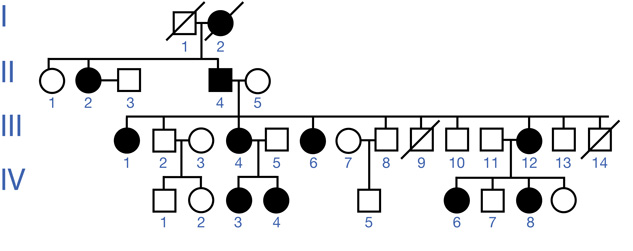
Identify the genotypes for individuals II-4, II-5, III-11, III-12, IV-6, IV-7, IV-8, and IV-9 in one of the lines of inheritance on the pedigree. (Provide a key for the allele symbols you use.) Construct a Punnett square to predict the probability of individuals III-11 and III-12’s next child being a male with CH. Explain why more females than males inherit CH in generation III.
Use the following information to answer the next three questions.
Deaf-mutism is an autosomal recessive trait that is caused by two genes. Individuals who are homozygous recessive for either gene will have deaf-mutism. The two genes are designated as D and E in the diagram below.

SC 3. Which of the following is a possible genotype of individual IV-3?
- ddEE
- ddEe
- DDee
- DdEe
SC 4. Individuals III-1 and III-2 are expecting their seventh child. What is the probability of this child having deaf-mutism?
- 0.00
- 0.25
- 0.50
- 0.75
Numerical Response
SC 5. What is the probability of a couple that are heterozygous for both genes having a child with deaf-mutism?
 Self-Check Answers
Self-Check Answers
SC 1.
Evidence of X-linked inheritance (autosomal):
- A greater number of males than females have the disorder. (The number of males and females with the disorder is roughly equal.)
- The disorder appears to be inherited from the maternal side of the family. (The disorder appears to be inherited from either gender parent equally.)
Evidence of recessive inheritance (dominant)
- Two parents without the disorder have a child with the disorder. (Two parents with the disorder have a child without the disorder.)
- The disorder skips generations. (The disorder is present in each generation or disappears completely from successive generations.)

Labelling of this pedigree should indicate the following evidence:
This pedigree does not show any evidence that males or females inherit the disease more often, so there is no evidence that it is sex-linked. The first generation (parents) do not have the disorder but two of their children have the disorder. This indicates that it is a recessive disorder which is not expressed in the parents who are carriers of the disease allele.
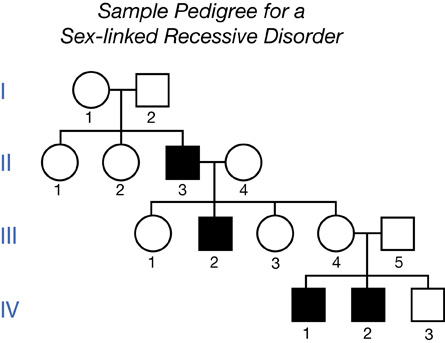
Labelling of the pedigree should indicate the following evidence:
This pedigree shows evidence that males inherit the disorder more often than females. This is consistent with a disease allele that is carried on the X chromosome. It is recessive since II-3 does not pass on the disease to any of his daughters, even though they would have a copy of his X chromosome with the disease allele.
SC 2.
Genotypes:
II-4: XCY
II-5: XcXc
III-11: XcXY
III-12: XCXc
IV-6: XCXc
IV-7: XcY
IV-8: XCXc
IV-9: XcXc
Alleles:
XC-CH
Xc-normal

- Probability of III-11 and III-12’s child being male with CH
(male with CH) XCY = or 25%
or 25%
- More females than males inherit CH in generation III because individual II-4, a male, has CH and, because CH is X-linked dominant, the father's XC will be passed on to all his female children in generation III (but not to his sons who received the father's Y chromosome).
SC 3. D
SC 4. A
SC 5. ![]()
 Reflect on the Big Picture
Reflect on the Big Picture
By building a pedigree of a real family, you have put into practice your knowledge of genetics. You can now visually display inheritance and appreciate how a pedigree can be used to analyze inheritance of a trait through a family’s history. You better understand how traits can be traced through your family, and you can understand how the variety and similarities are expressed in your family.
 Module 6: Lesson 10 Assignment
Module 6: Lesson 10 Assignment
Submit your completed Module 6: Lesson 10 Assignment to your teacher for assessment.
Before beginning your Module Assessment, you may choose to do a selection of questions from page 606 and page 609 of your textbook. Discuss your responses with your teacher.
Review and complete your choice of Module Assessment and submit your work to your instructor.
Remember you also have the option of trying additional questions from the textbook for further practice. Consult with your teacher for the answers to these questions. The Key will also provide you with many Diploma Exam-style multiple-choice, numerical-response, and written-response questions that will be an excellent review of the module. Practising your responses to these types of questions is good preparation for the Diploma Exam.
1.47. Page 4
Module 6—Mendelian Genetics: The Transmission of Traits to the Next Generation
 Lesson Summary
Lesson Summary
During this lesson you explored the following focusing question:
- What technologies exist to help explain and predict the inheritance of traits in breeding programs or family histories?
Pedigrees and Punnett squares are two excellent technologies that help visually represent inheritance. They can be used to predict the probabilities of future expressions of a trait, and can also help determine the mode of inheritance of that trait.
Lesson Glossary
autosomal dominant: these conditions appear in each generation in the pedigree, and cannot arise from two parents who did not have the condition
autosomal recessive: these conditions often skip a generation in a pedigree, and are indicated if two parents without the condition produce a child with the condition
autosomal: a condition is autosomal if the pedigree shows no significant difference in the number of each gender affected by the condition
pedigree: a picture of a family history of a genetic condition that indicates generation, gender, birth order in the generation, and parental and offspring relationships; the presence of the condition is indicated by a blackened-in symbol
X-linked dominant: a condition is X-linked dominant if the pedigree shows the condition is found in females significantly more than in males
X-linked recessive: a condition is X-linked recessive if the pedigree shows the condition is found in males significantly more than in females; carrier moms pass the allele to affected sons; affected sons cannot pass the allele to their sons, but pass it to their daughters, who in turn become carriers
1.48. Module Summary/Assessment
Module 6—Mendelian Genetics: The Transmission of Traits to the Next Generation
 Module Summary
Module Summary
In this module, you explored the basic principles and concepts of dominance, segregation, and independent assortment. You analyzed ratios and probabilities of genotypes and phenotypes and applied this understanding to examine the many other possible ways traits can be transmitted from generation to generation. You discovered how variability can be dependent on the number of genes involved in a trait, crossing over, and gene linkage. You also learned why some traits, like hemophilia, are more common in males than in females. You are now aware of some of the many technologies that can be used to study the transmission of traits. In this module, you used some of these tools in your study of heritable traits.
Until Gregor Mendel conducted careful breeding experiments with garden peas, the moving of traits from one generation to another was a mystery. Using Mendel’s basic principles, we can now create more effective breeding programs for agriculture, or give meaningful council to young couples about the chances of their baby having a unique disorder. Combining those principles with Morgan’s evidence that genes occur on chromosomes, we can create tests for the presence of genes, and even target specific genes for transfer to other organisms. With the conclusion of the human genome project, we now have a complete map of all human genes. As scientists work to discover how genes work together and how each gene is expressed, we will come closer to understanding our complete genetic make up, enabling us to better predict the results of future generations, and even manipulating those results to meet our needs and/or desires.

© Kameel4u/shutterstock
 Module Assessment
Module Assessment
You may choose to complete Task 1 or Task 2.
Task 1: Analyzing Familial Mediterranean Fever (FMF) (24 marks for questions + 12 marks for presentation = 36 marks)
Familial Mediterranean Fever (FMF) results in short but re-occurring episodes of fever, as well as pain in the chest, joints, and abdomen. The disease occurs most frequently in individuals of Mediterranean descent. The gene responsible for FMF was discovered on chromosome 16 in 1997. The following pedigree shows the occurrence of this disorder in one family.
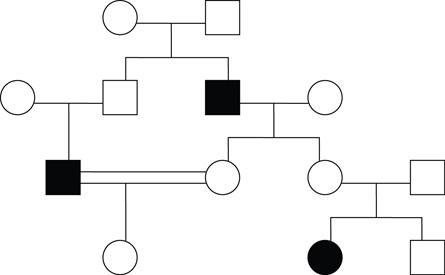
Complete the following tasks and questions:
- Label the diagram with the correct Roman and Arabic numbering. (4 marks)
- What is the mode of inheritance for FMF? (2 marks)
- Provide the phenotypes and genotypes of all the individuals in the pedigree. (6 marks) Whose genotype can you not be sure of? (2 marks)
- III-3 and III-4 are planning on having another child. What are the chances they will have another daughter with FMF? Construct a Punnett square to demonstrate this cross. (6 marks)
- FMF often occurs with a genetic link to increased sneezing and wheezing. It turns out that both the sneezing trait and the wheezing trait are recessive and carried on chromosome 16 as well. Using the following information, construct a scale gene map of chromosome 16. (4 marks)
- Crossover frequency between sneezing and FMF: 4.5
- Crossover frequency between wheezing and FMF: 8.5
- Crossover frequency between sneezing and wheezing: 4.0
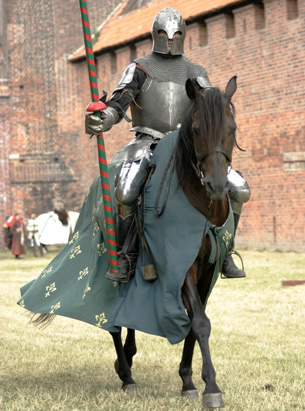
© afro/shutterstock
You are a summer student working for the Royal Alberta Museum. The museum is going to put on a new display featuring Medieval Europe. As part of the display, the curators are hoping to educate people on the inherited diseases of the royal families of Europe. Your job is to create a display illustrating the occurrence of hemophilia in Queen Victoria and Prince Albert’s family. Your display will need to explain the mode of inheritance and the likelihood of certain family members having the disorder. You may create a poster, tri-board display, or digital exhibition such as a PowerPoint or video. Your display should also be attractive to visitors of the museum.
Your display must include answers to all of the following questions and/or instructions:
- Create a pedigree for three generations, including Queen Victoria and Prince Albert. Label the diagram with the correct Roman and Arabic numbering. (4 marks)
- What is the mode of inheritance for hemophilia? How do you know this from the information you end up with in the pedigree? (2 marks)
- Provide the phenotypes and genotypes of all the individuals in the pedigree. (6 marks) Whose genotype can you not be sure of? (2 marks)
- If Alfonso XIII and Victoria had had another child, what would be the chance of them having a son with hemophilia? Construct a Punnett square to demonstrate this cross. (6 marks)
- Hemophilia often occurs with a genetic link to colour-blindness or pattern baldness. It turns out that both the colour-blindness trait and the pattern balding trait are recessive and are carried on chromosome 16 as well. Using the following information, construct a scale gene map of the X chromosome. (4 marks)
- Crossover frequency between balding and hemophilia: 17.5
- Crossover frequency between colour-blindness and hemophilia: 8.5
- Crossover frequency between balding and colour-blindness: 9.0
In addition to the questions/instructions above, your teacher may decide to mark the format of your presentation using the following rubric as a guide:
Museum Display Rubric
| Level | Descriptions |
4 |
|
3 |
|
2 |
|
1 |
|
1.49. Module Glossary
Module 6—Mendelian Genetics: The Transmission of Traits to the Next Generation
Module Glossary
Consult the glossary in the textbook for other definitions that you may need to complete your work.
addition: to add or sum
autosomal: refers to a trait that is due to a gene on one of the first 22 pairs of chromosomes—not the sex chromosomes; autosomal traits occur equally in males and females
autosomal: a condition is autosomal if the pedigree shows no significant difference in the number of each gender affected by the condition
autosomal dominant: these conditions appear in each generation in the pedigree, and cannot arise from two parents who did not have the condition
autosomal recessive: these conditions often skip a generation in a pedigree, and are indicated if two parents without the condition produce a child with the condition
autosomal recessive: a condition caused by a gene found on an autosome (non-sex chromosome), which only occurs in those with the homozygous recessive genotype
biodiversity: the variation present in the genes, species, and ecosystems of a biome; at the species level refers to the variety of alleles, genotypes, and phenotypes present for each gene; used as an indicator of the biological health of a species, ecosystem, or biome
chromosomal theory of inheritance: the theory that chromosomes are strings of genes and that each gene has a specific location on a specific chromosome
co-dominance: similar to incomplete dominance—neither allele is dominant; in the heterozygote, both distinct phenotypes appear—not a mixture, e.g., red and white cow colour alleles produce red and white hairs in the heterozygote; in blood types the AB heterozygote makes both A antigens and B antigens—not a mixture
continuous traits: traits that have a range of phenotypes, such as human height or eye colour with its many shades; is due to the polygenic effect of many genes together
contrasting characteristic: a trait that has two alleles that are expressed in a different way (e.g., the trait for height in pea plants can have the contrasting characteristics of tall or short)
crossover percentage: same as recombination frequency
dominant: if two alleles are present, the allele that is expressed is the dominant one (e.g., if an individual has both tall and short alleles, but is tall, then tall is dominant over short)
environment: all non-genetic factors that affect a person’s characteristics; e.g., how he or she was raised, light levels, friends, temperature, good and bad experiences, diet and nutrients available, and so on
epistasis: a type of polygenic inheritance where two genes collectively determine a phenotype of a trait; e.g., the B gene codes for type of colour (B = black, b = brown) and the C gene determines whether colour occurs at all (C = colour, c = no colour); three phenotypes result—white, brown, and black
expression: refers to the transcription and translation of the gene to produce the requested protein
Whether or not an allele will be expressed is affected by whether or not the allele is dominant; whether the product is needed by the cell; the stage of the life cycle; and, to some degree, the environmental conditions. In undifferentiated cells, all genes are expressed; in differentiated cells only some genes are expressed.
F1 generation: offspring of the P1 generation; F stands for filial generation—meaning brothers and sisters
F2 generation: offspring produced as a result of individuals of the F1 generation mating with other individuals of the F1 generation
factor: the term used by Gregor Mendel to explain inheritance of a trait; today we use the term gene
filial: the offspring of a cross
genotype: what the genes say; two symbols that indicate which alleles the individual has for a particular trait (e.g., Tt)
hemophilia: an X-linked recessive condition; caused by the recessive allele of the Factor VIII gene on the X chromosome; characterized by inability to clot blood
heterozygous: a genotype where the alleles are different (e.g.,Tt)
homozygous (true breeding): a genotype where both alleles are the same (e.g. ,TT is homozygous dominant, tt is homozygous recessive)
hybrid: the offspring of two parents with different inheritable traits; often termed heterozygous
incomplete dominance: some genes have two alleles—neither of which are dominant; in the heterozygote the phenotype is a mixture of both alleles; e.g., if the white and black alleles are incompletely dominant, the heterozygote will be grey
inheritable trait: a characteristic that is determined by genes, not the environment; a trait that is capable of being passed from parent to offspring
innate: a characteristic one is born with
law of independent assortment: during meiosis, any allele from one trait can end up in the same gamete with any allele from another trait; e.g., an individual with the DdGg genotype can produce DG, Dg, dG, or dg gametes; only applies to genes that are not linked on the same chromosome
law of segregation: the two genes that an organism has for each trait are separated during meiosis so that only one gene can enter a gamete; explains why body cells are diploid, but gametes are haploid
linked genes: genes that exist on the same chromosome; e.g., if the acne gene and belly fat gene are on the same chromosome, then they are linked; with A and B linked together and a and b linked together, or vice versa
malaria: a disease of warm, wet areas caused by the plasmodiumprotist found in the Anopheles mosquito
When the mosquito bites a person, the plasmodium enters the blood stream and lays its eggs in red blood cells. Sickled red blood cells typical of those people with sickle cell anemia (SCA) are harder for the plasmodium to attack, so those with SCA are less likely to die of malaria. The homozygous recessive condition (ss) confers a disadvantage (SCA) and an advantage (protection from malaria).
map distance: how far apart (in centimorgans) two genes are on a chromosome; the recombination frequency from a linkage cross is used as the map distance between two genes; e.g., 44% of the offspring of the linkage cross were recombinants, therefore the two genes are 44 map units or 44 cM apart.
map unit: the unit used is the centimorgan (cM); because the recombination frequency is a percentage, the largest map distance is 100 cM
monohybrid: an organism that is heterozygous for one trait e.g., Tt
monohybrid cross: a cross of two individuals, each of which is heterozygous for one trait (e.g., Tt X Tt; always produces a 1:2:1 genotypic ratio and 3 dominant to 1 recessive phenotypic ratio)
multiple alleles: some genes have more than two alleles; an order of dominance is given to determine phenotypes from genotypes; e.g., in a particular flower, colour alleles are red, amber, yellow, and albino in order of decreasing dominance
nature: in reference to the nature versus nurture debate, refers to the components of an individual’s phenotypes that are determined by his or her genes; e.g., approximately 50% of intelligence is thought to be due to nature
non-parental type: in a linkage cross, any offspring of the above cross that don’t look like the parents (Aabb or aaBb) are non-parental types, are the results of crossing over, and are recombinants
nurture: refers to the component of one’s phenotypes that are determined by one’s environment
P1 generation: the first set of parents; parents of the F1 generation
parental type: in a linkage cross, if the offspring look like either parent, then they are parental types; e.g., if we assume A and B are linked together and a and b are linked together in the linkage cross AaBb X aabb, any offspring that are AaBb or aabb are parental types
pedigree: a chart outlining the generations and relationships within a family line
pedigree: a picture of a family history of a genetic condition that indicates generation, gender, birth order in the generation, and parental and offspring relationships; the presence of the condition is indicated by a blackened-in symbol
phenotype: the observable characteristic of the organism e.g., tall height or short height; is determined by genotype e.g., the Tt genotype results in a tall phenotype
phenotypic ratio: a proportion expressing all the possible visible physical traits in a generation
pleiotropy: the reverse of polygenic inheritance; where one gene affects the phenotypes for several traits; e.g., the PKU gene affects mental retardation, skin colour, hair colour, and other traits
polygenic inheritance: where more than one gene (often several) are involved in determining the phenotype for one characteristic; e.g., eye colour is actually the result of multiple genes that collectively contribute to the final eye colour
probability: the likelihood of an event occurring; can be expressed as a decimal (0.20), fraction (![]() ), or percentage
), or percentage
product: to multiply
progeny: offspring
pure: an individual with both alleles for a trait being dominant, or recessive
recessive: if two alleles are present, the allele that is hidden is recessive
recombination: during crossing over in prophase I of meiosis, genes from non-sister chromatids trade places, making new allele combinations in the gametes; e.g., if A is linked to B and a to b, then any gametes that are Ab or aB are the results of recombination or crossingover.
recombination frequency: the number of recombinant offspring divided by the total number of offspring X 100; expressed as a percentage; used as a map distance between the two genes; e.g., the recombination frequency was 32%, therefore the two genes are 32 map units apart on the chromosome
selective breeding: choosing stock because of its physical, behavioural, or functional characteristics
sex-linked: a trait that is found in one gender more than another; contrary to autosomal traits that are found equally in both genders
sickle cell anemia (SCA): an autosomal recessive disease that causes sickle-shaped red blood cells to form, which get caught in blood vessels, stopping blood flow to tissues
test cross: a cross done to determine the genotype of an individual with a dominant phenotype; the individual with the unknown genotype is mated with a homozygous recessive individual—if any offspring have the recessive phenotype, the unknown is a heterozygote
trait: a characteristic
trihybrid: a genotype that is heterozygous for three traits, for example AaBbCc; sometimes used in a general way to refer to genetics problems using three traits
X-linked: a trait that is found in one gender more than in the other gender, and so is sex-linked; contrairy to autosomal traits, which are found equally in both genders
X-linked dominant: a condition is X-linked dominant if the pedigree shows the condition is found in females significantly more than in males
X-linked recessive: a condition is X-linked recessive if the pedigree shows the condition is found in males significantly more than in females; carrier moms pass the allele to affected sons; affected sons cannot pass the allele to their sons, but pass it to their daughters, who in turn become carriers